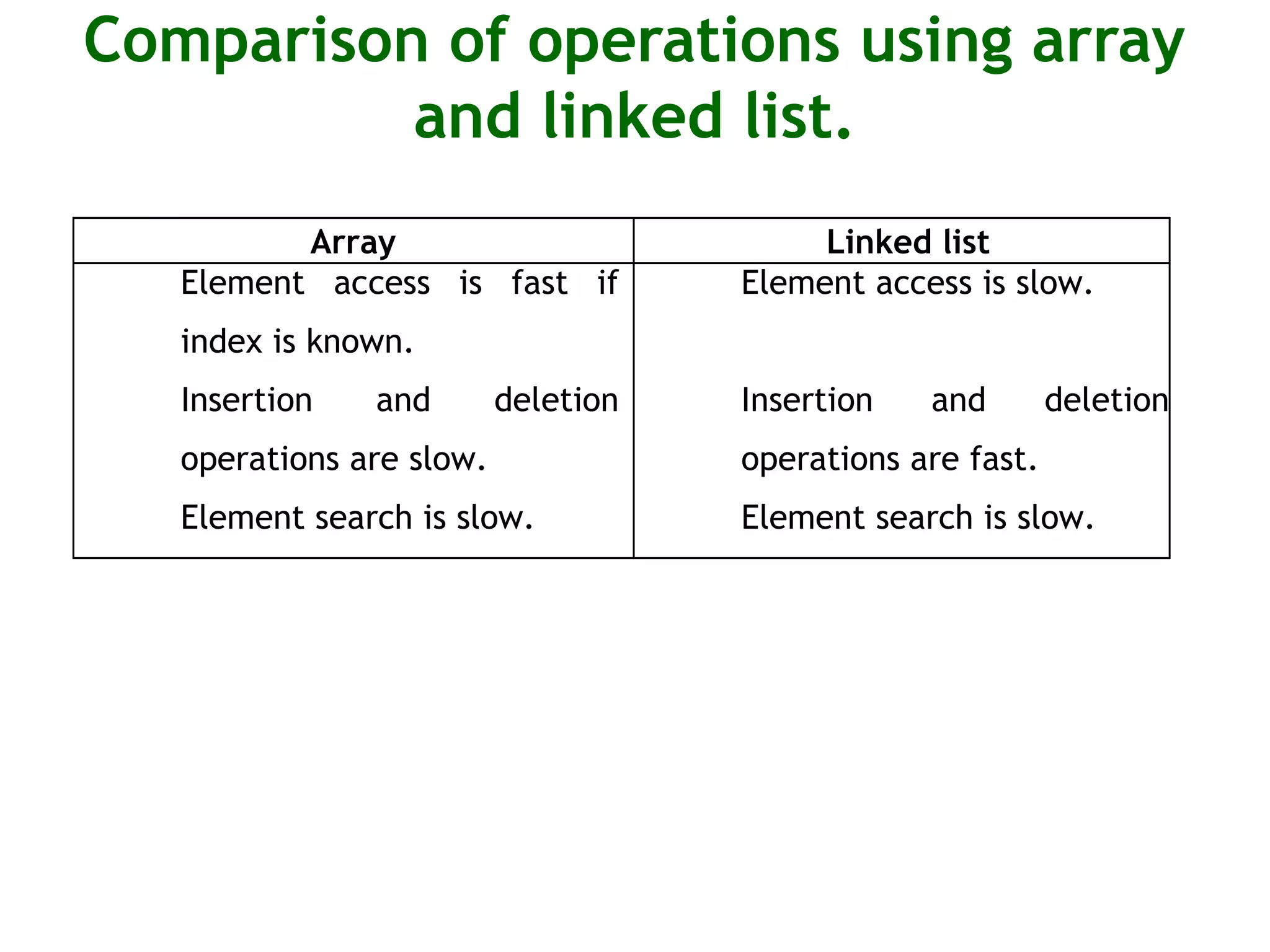The document provides a comprehensive overview of linked lists, outlining their advantages over arrays, the structure of nodes, and basic operations such as insertion, deletion, and searching. It covers both linear and doubly linked lists, including detailed pseudocode for creating and manipulating these data structures. Additionally, it discusses memory allocation, garbage collection, and variations like circular linked lists.



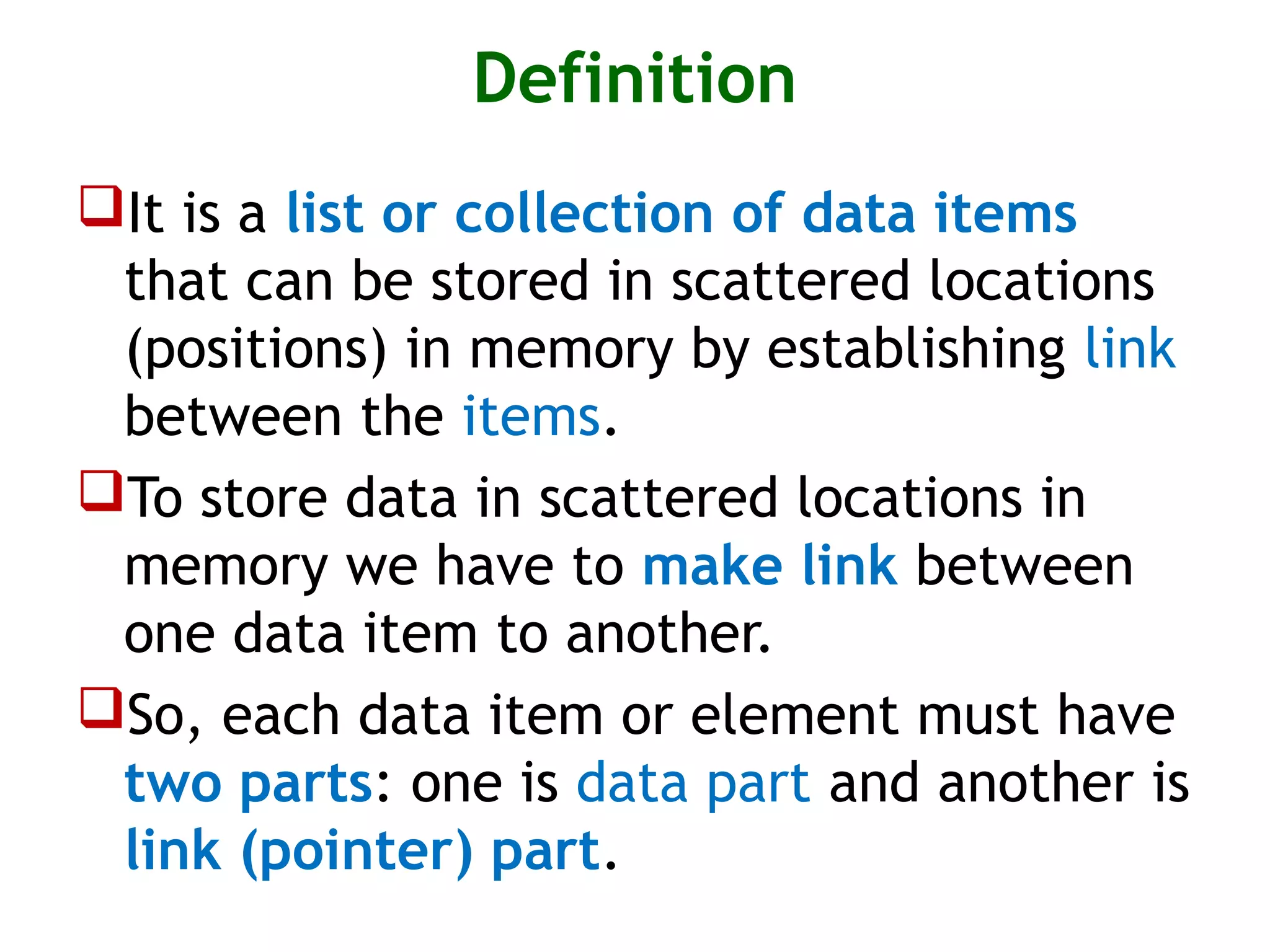
![Definition [cont..] Each data item of a linked list is called a node. Data part contains (holds) actual data (information) and the link part points to the next node of the list. To locate the list an external pointer is used that points the first node of the list. The link part of the last node will not point any node. That means it will be null. This type of list is called linear (one way) linked list or simply linked list.](https://image.slidesharecdn.com/linkedlist-chapter-5-180906055232/75/Data-Structures-with-C-Linked-List-5-2048.jpg)
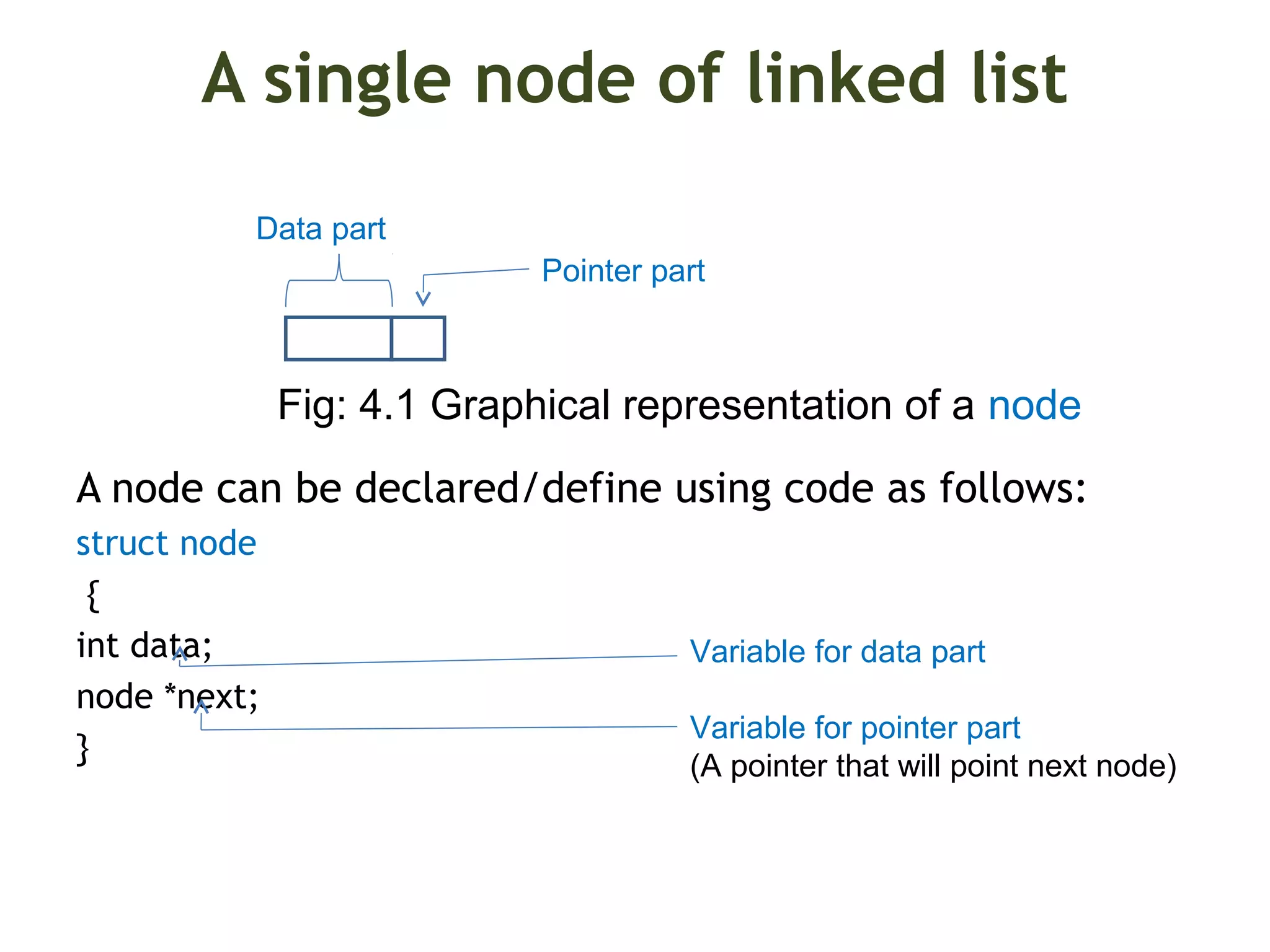

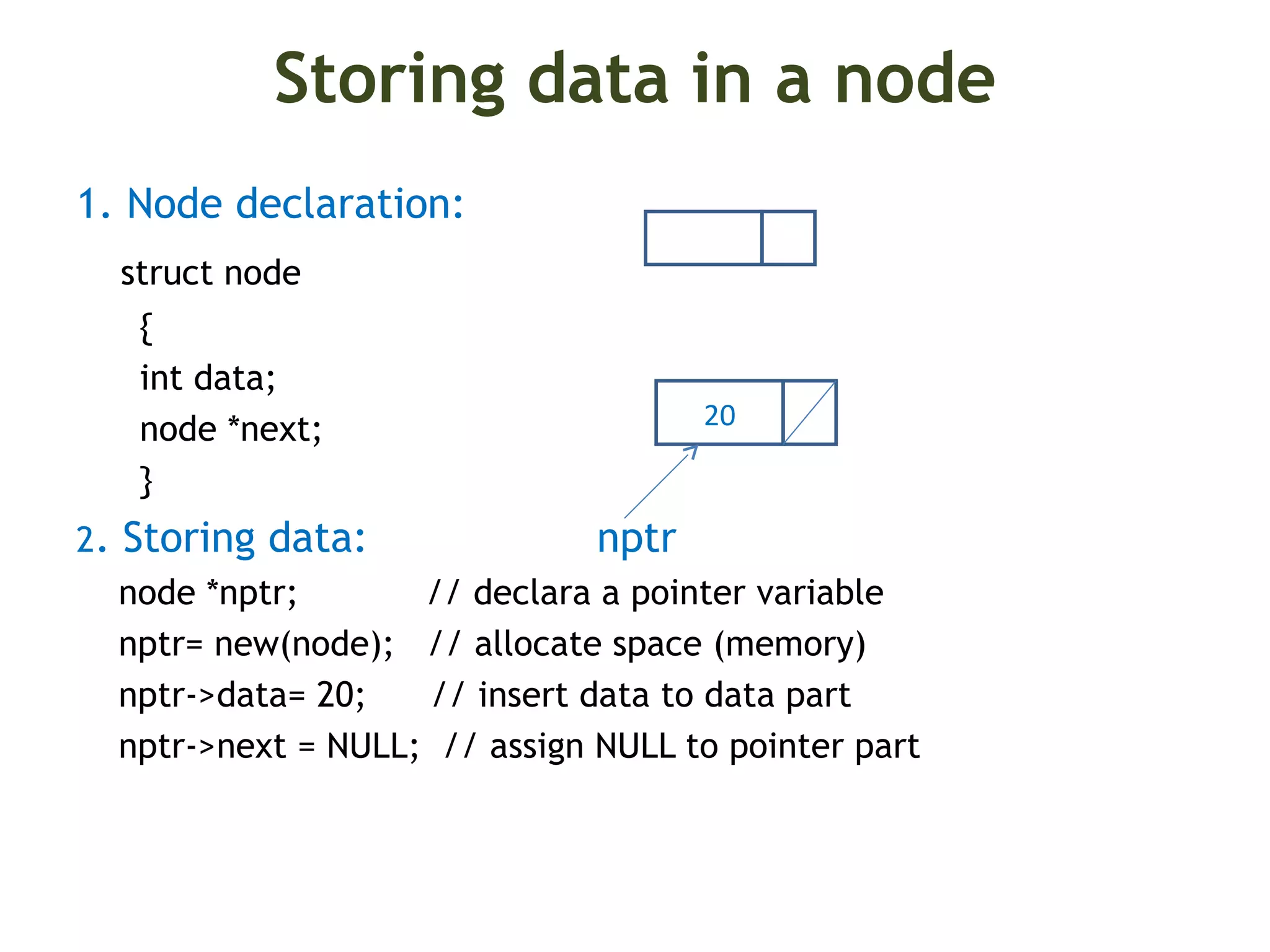
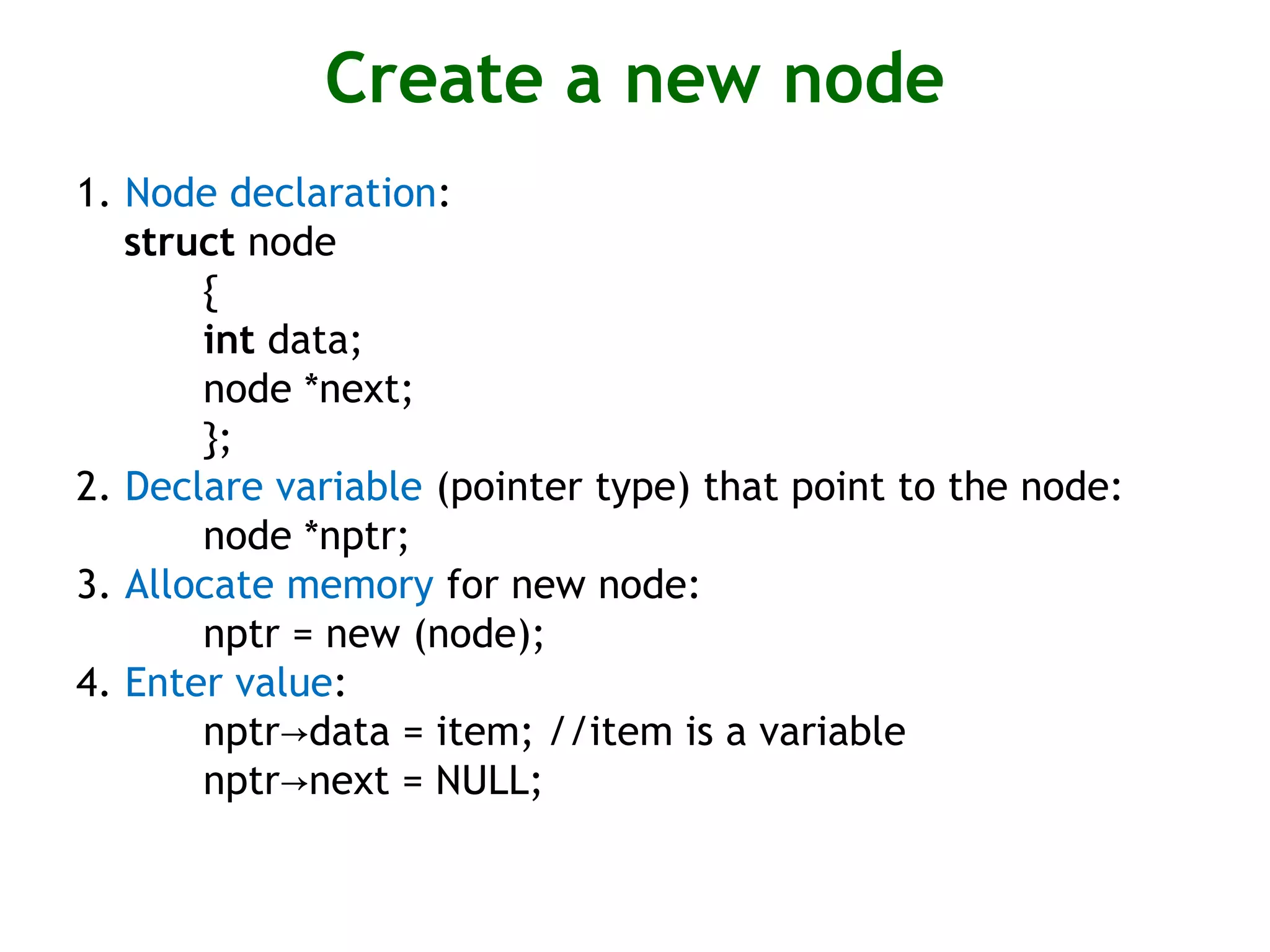

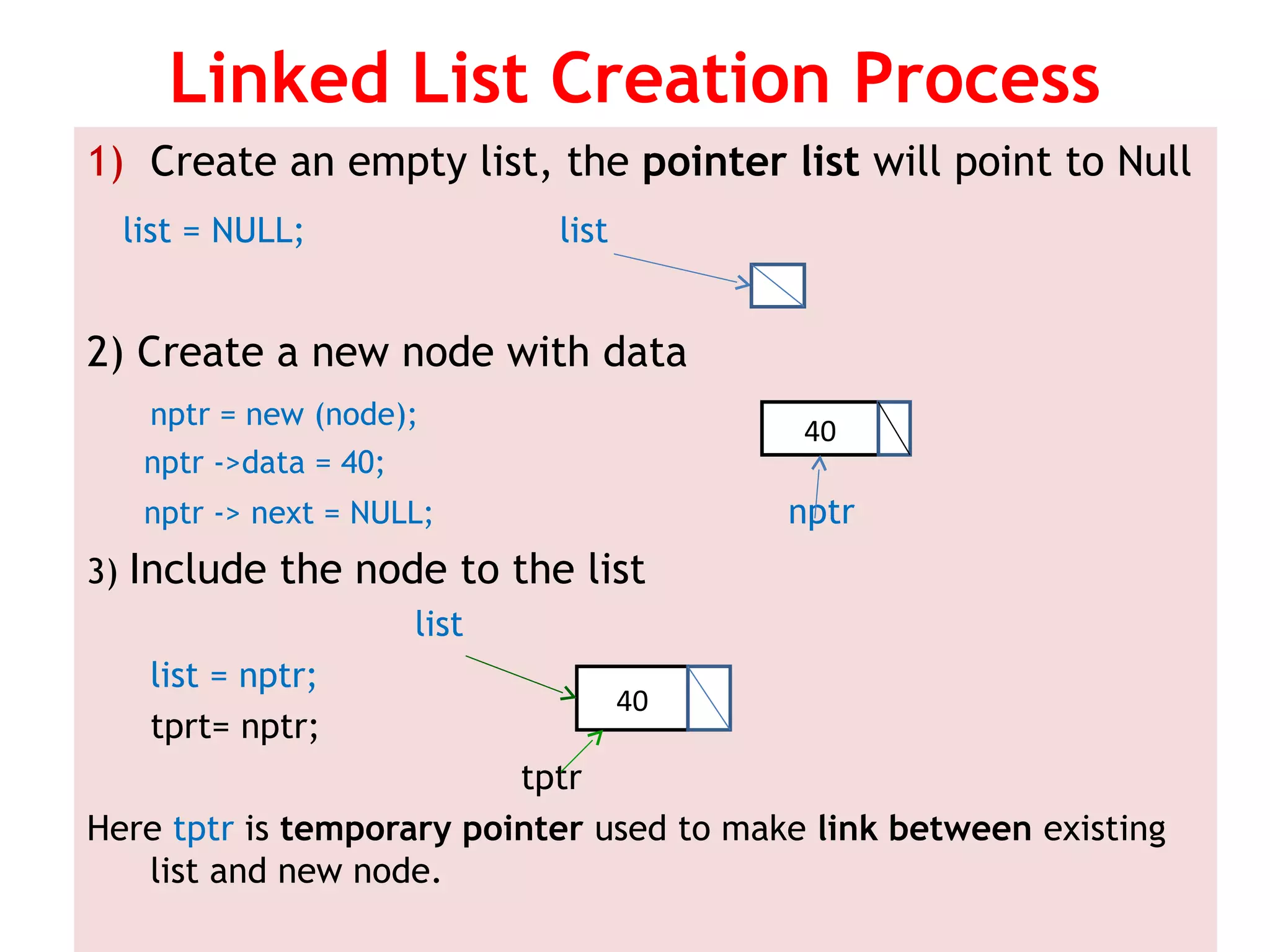
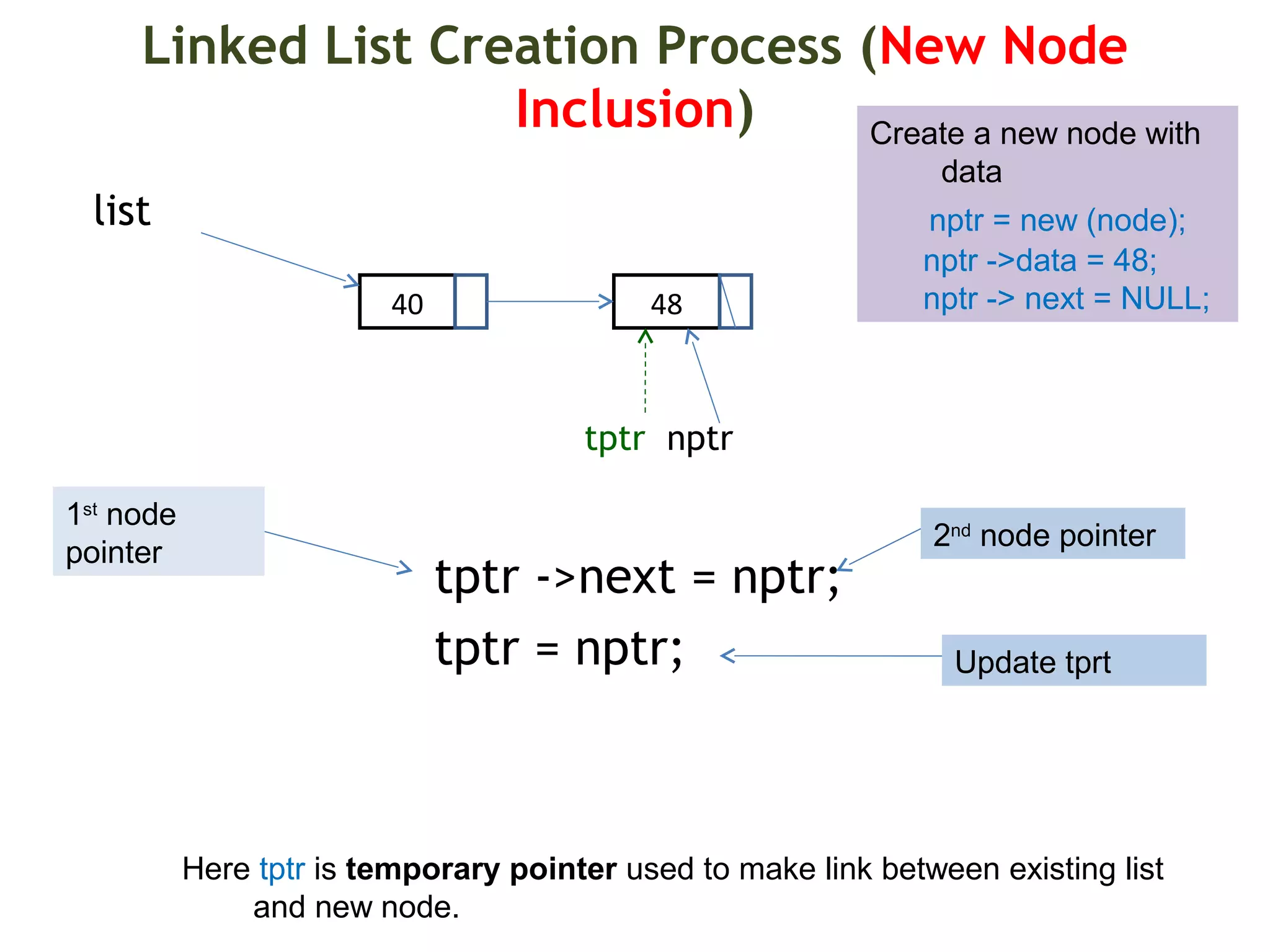



![Program [Cont..] cout<<"Enter data for node with space:"; for (i=1;i<=n;++i) { cin>>item; nptr=new (node); // node *nptr nptr->data=item; nptr->next=NULL; if (list==NULL) //List is empty { list=nptr; //Include first node tptr=nptr; // temporary pointer } //There is/are node(s) else { tptr->next=nptr; tptr=nptr; } } // end of for loop // address of current/successive node assigned to the next part of preceding node](https://image.slidesharecdn.com/linkedlist-chapter-5-180906055232/75/Data-Structures-with-C-Linked-List-16-2048.jpg)
![Program [Cont..] //Display data tptr=list; for (i=1; i<=n;++i) { cout<<endl; cout<<tptr->data; // print the value of the first node tptr=tptr->next; // move to the next node cout<< " "; } cout<<endl; cout<<endl; }](https://image.slidesharecdn.com/linkedlist-chapter-5-180906055232/75/Data-Structures-with-C-Linked-List-17-2048.jpg)
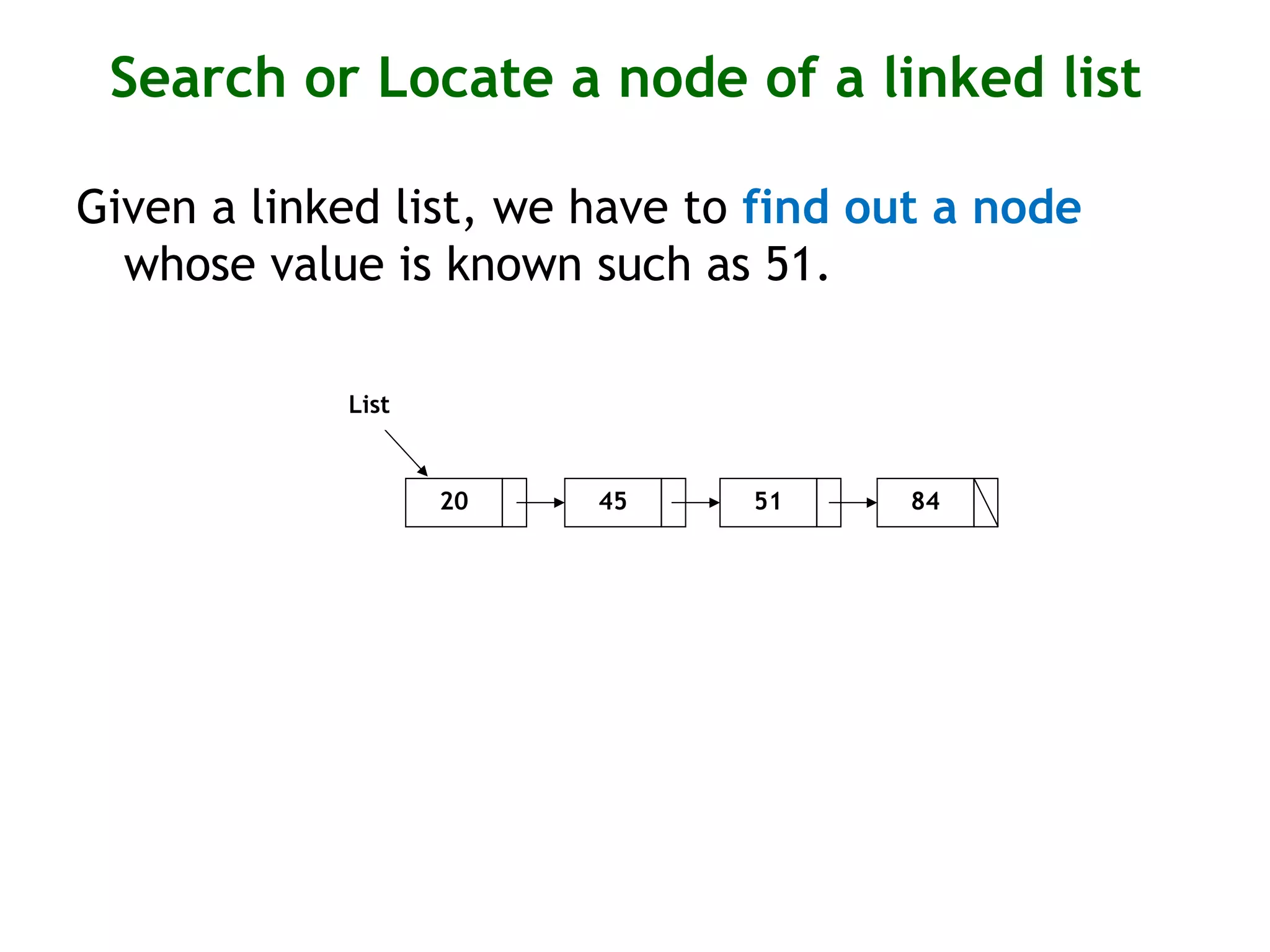

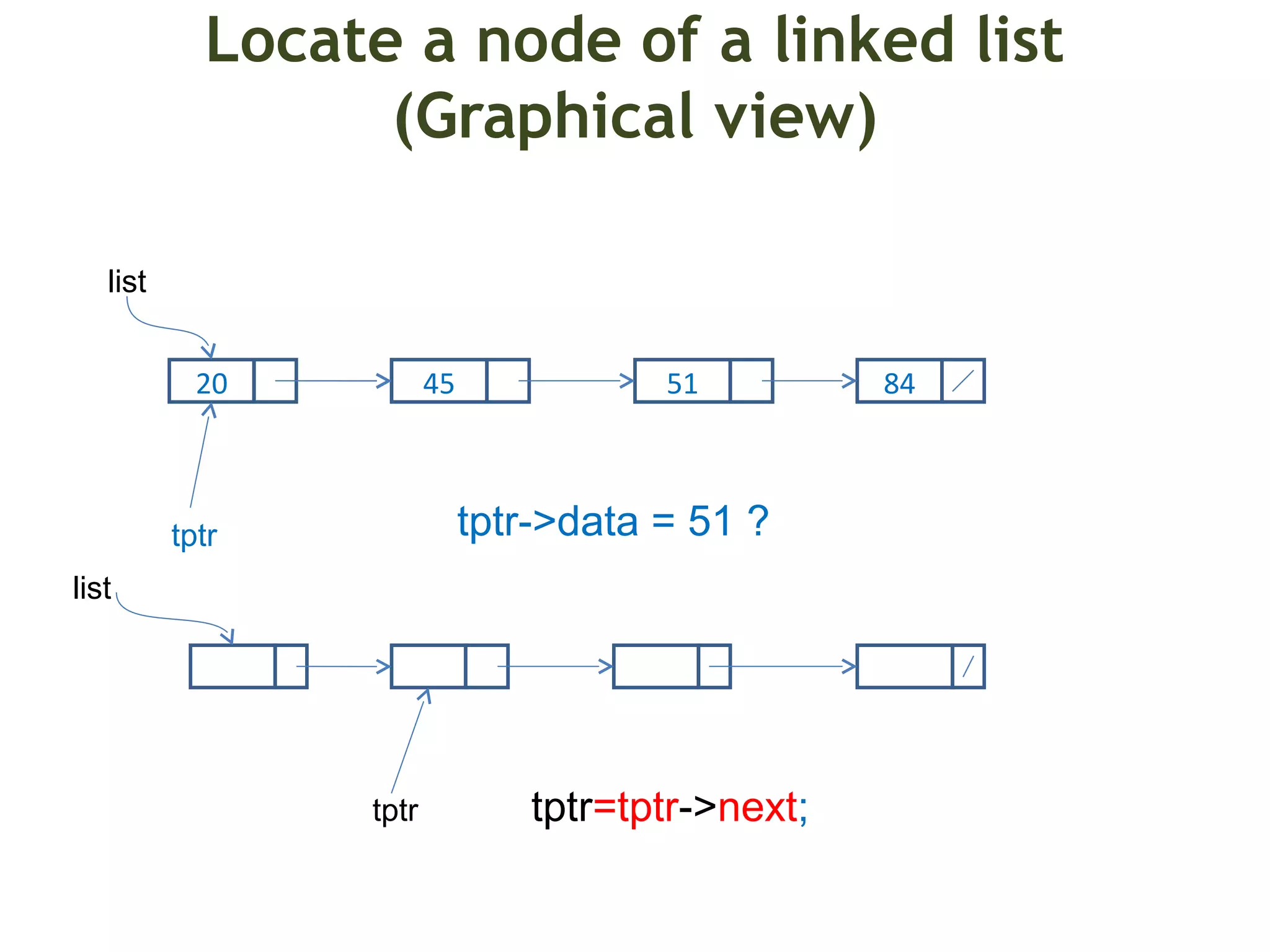
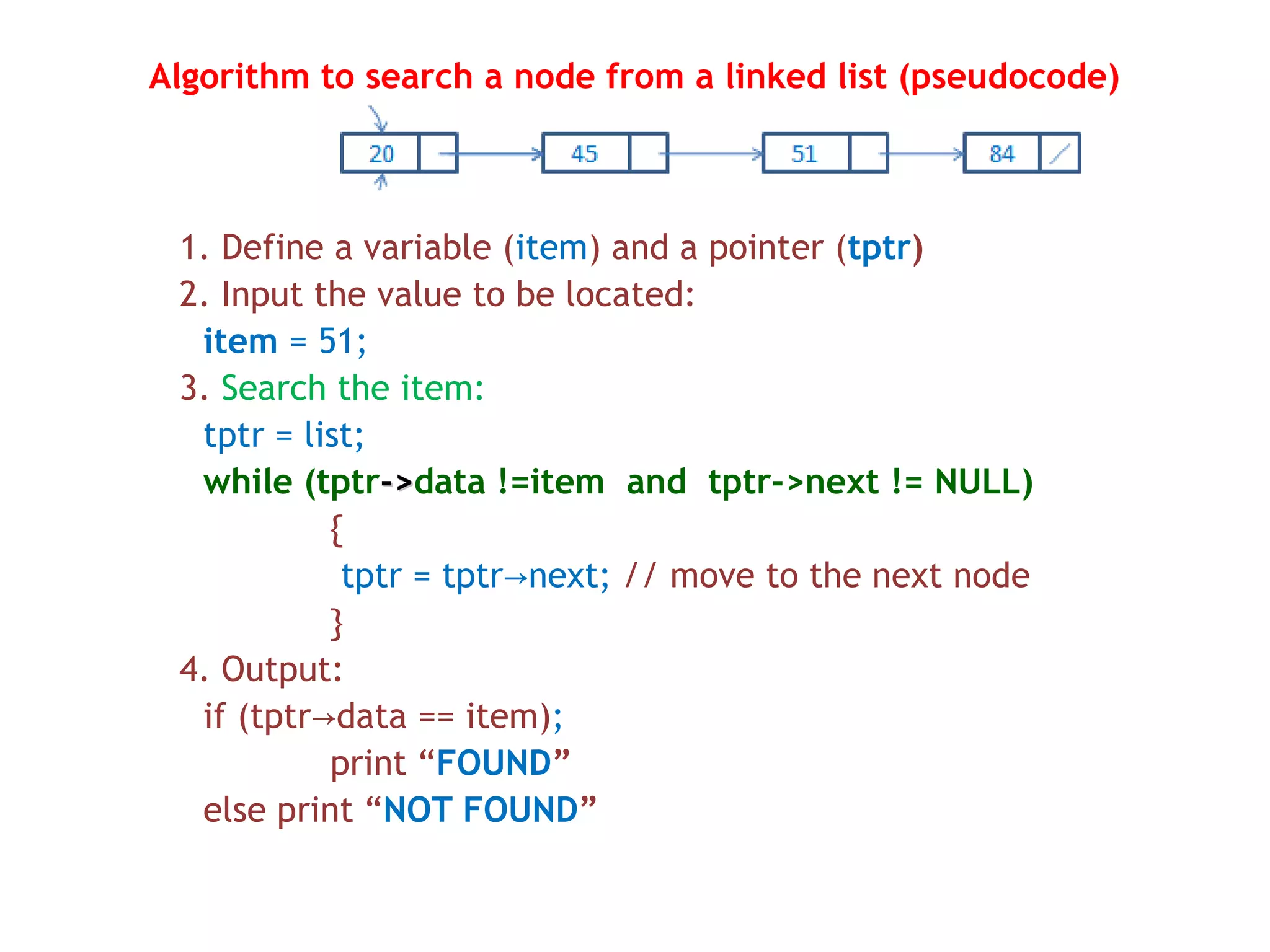

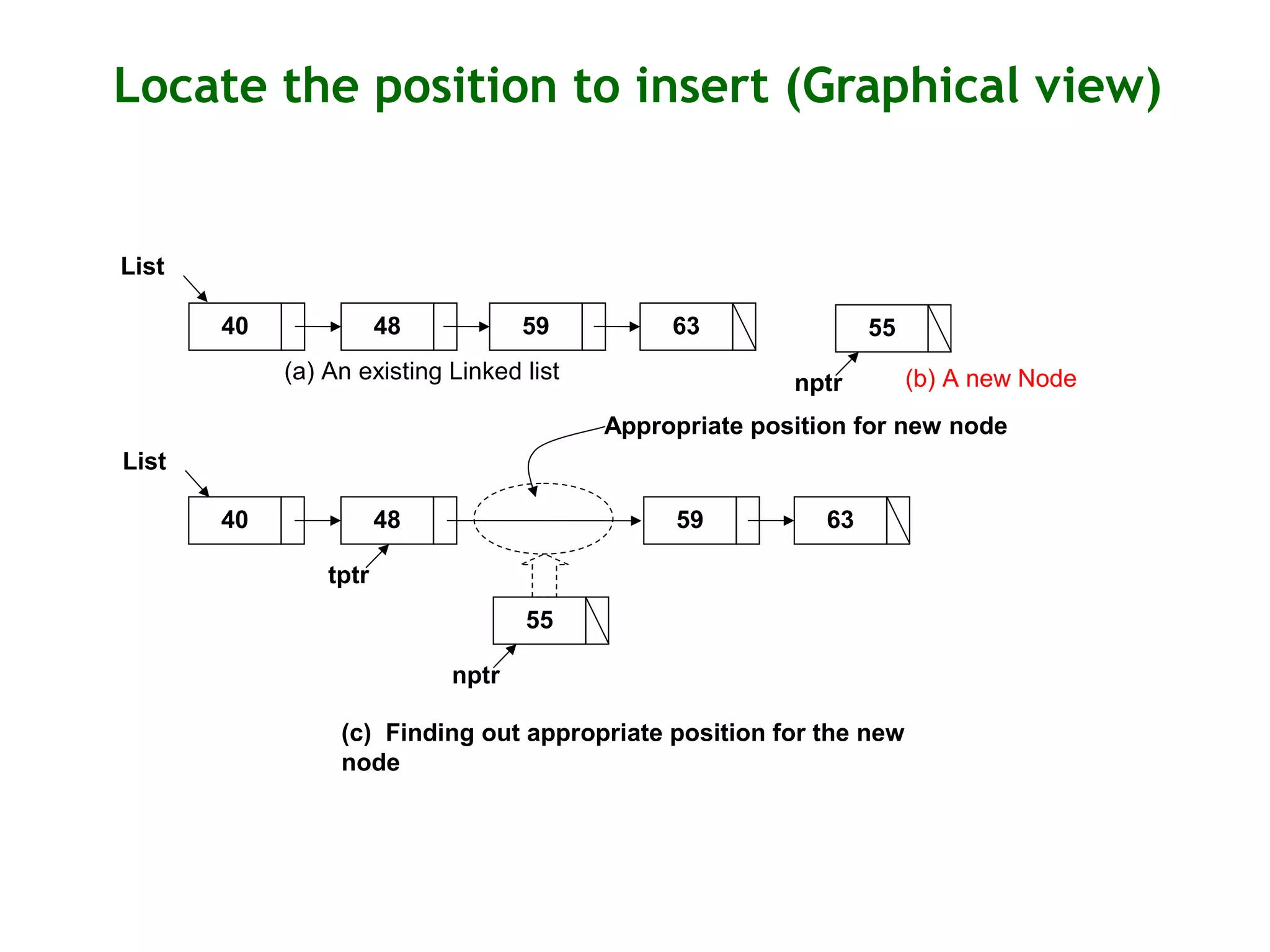
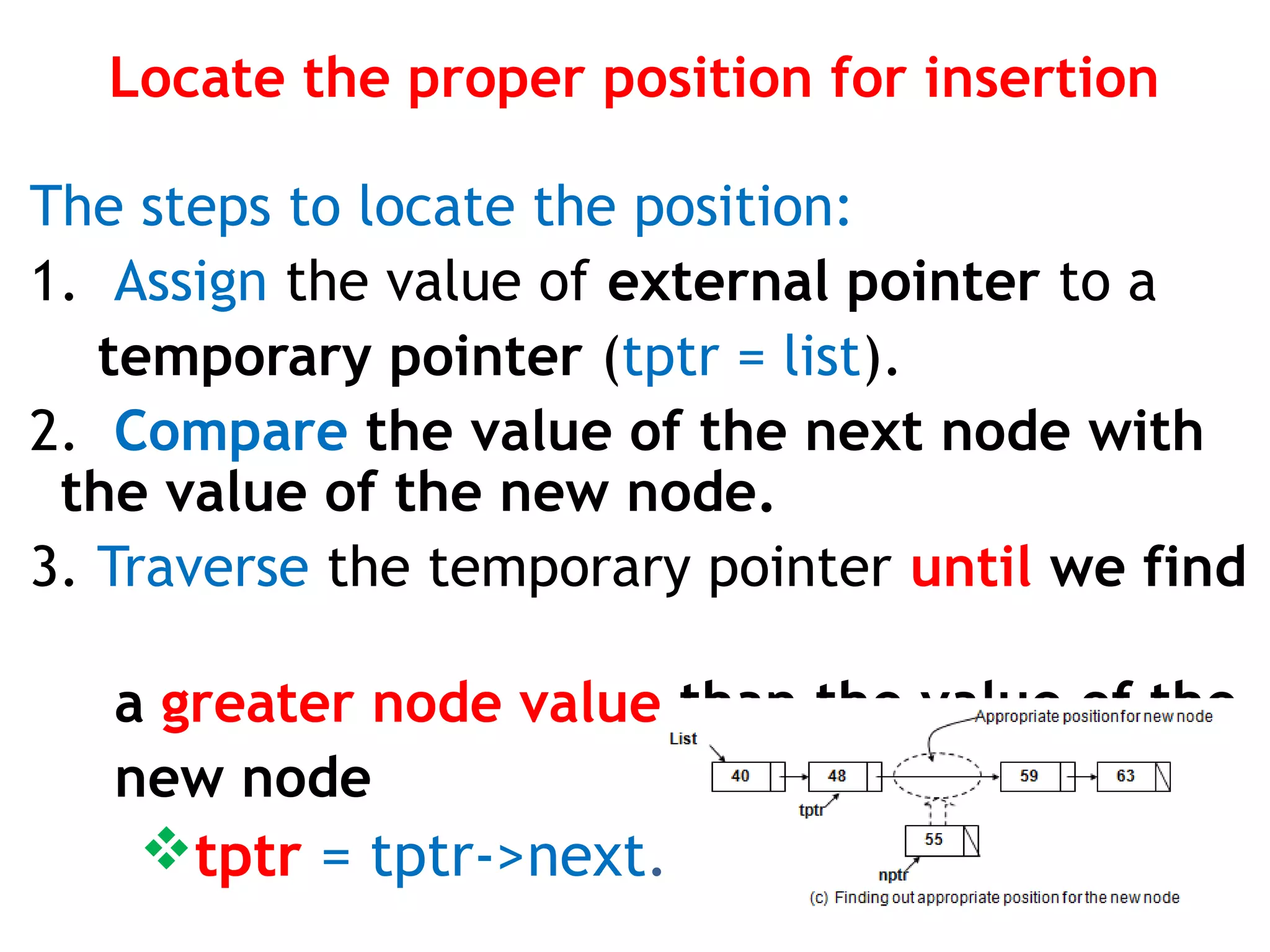
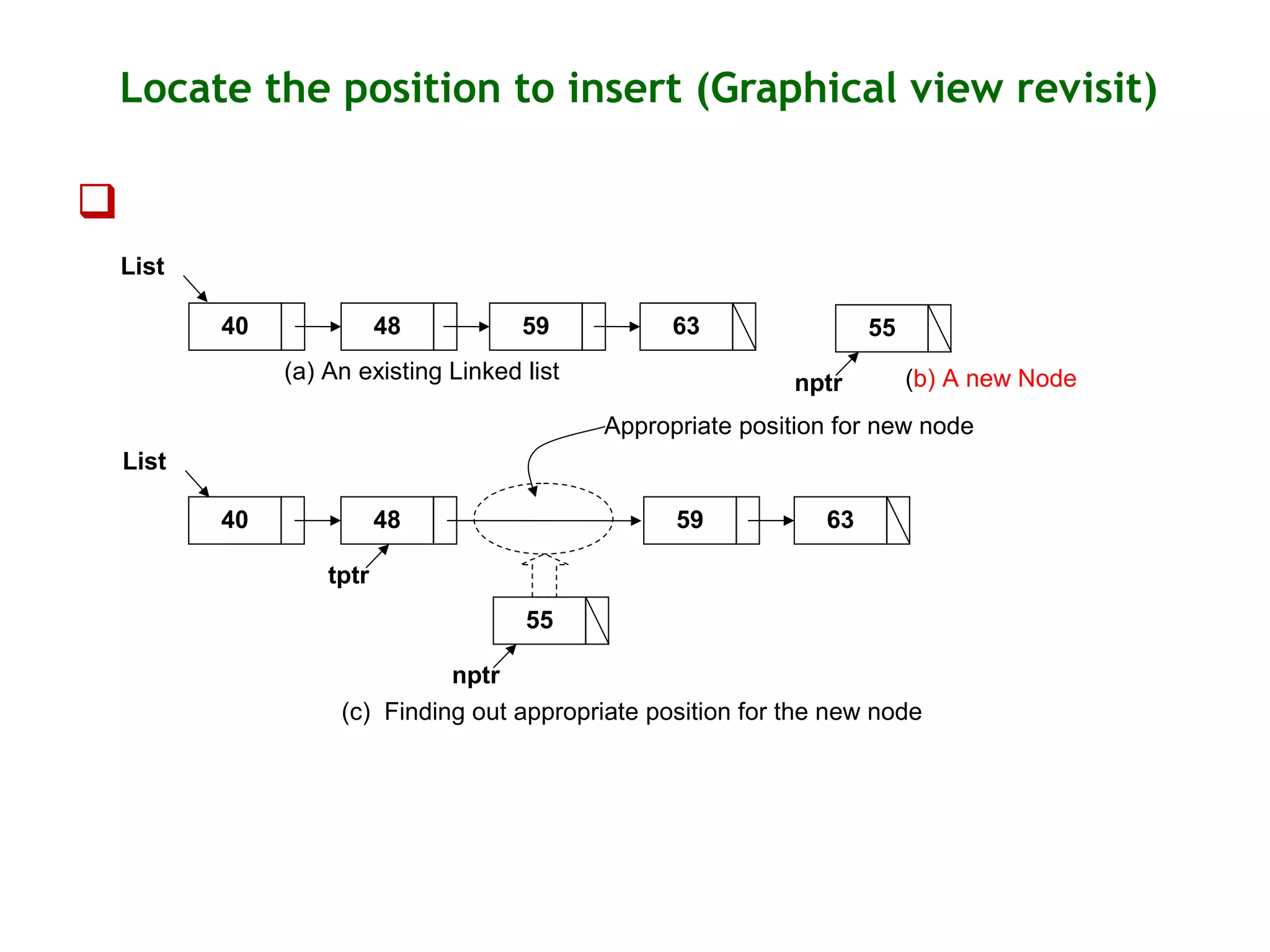
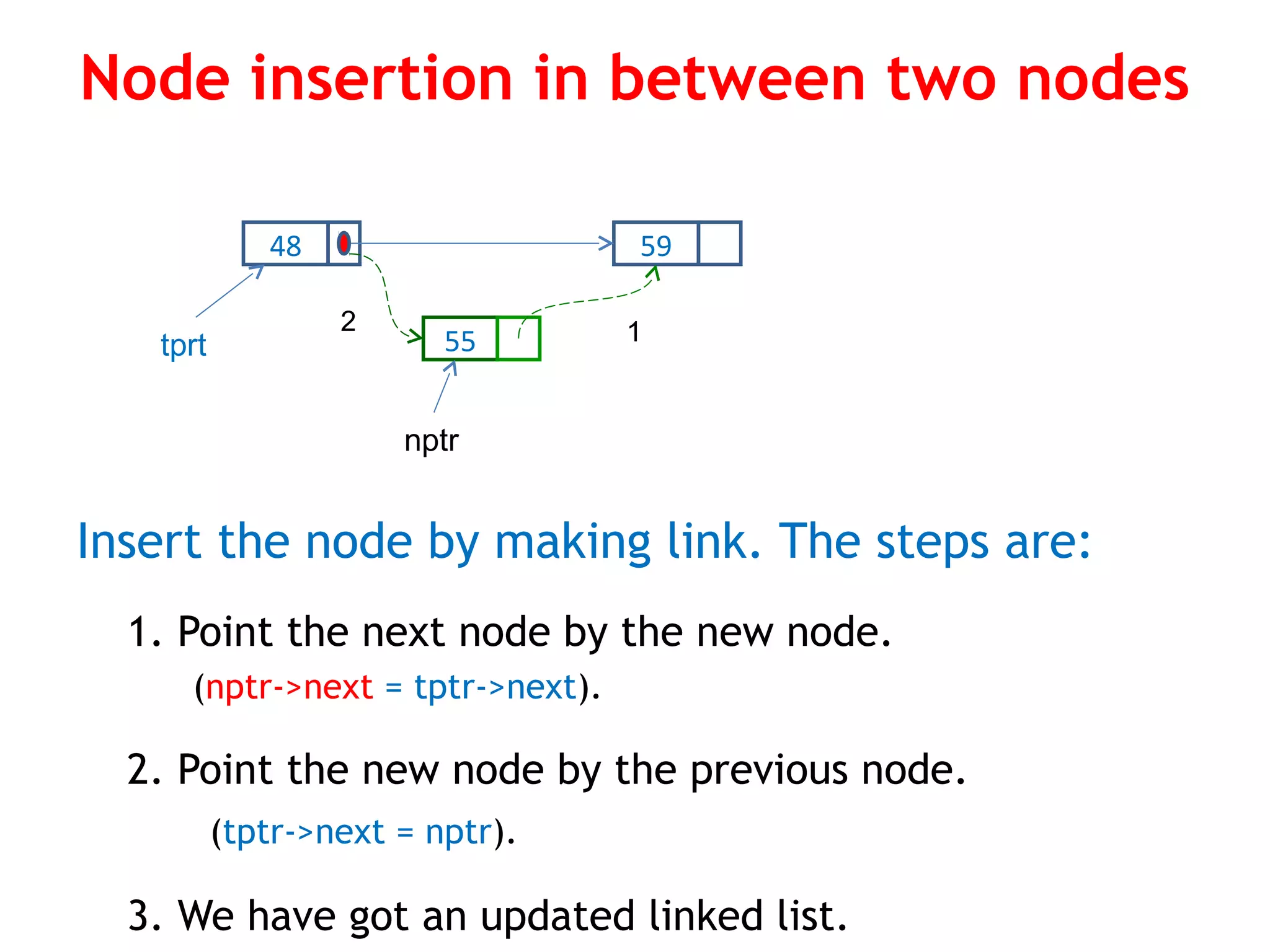
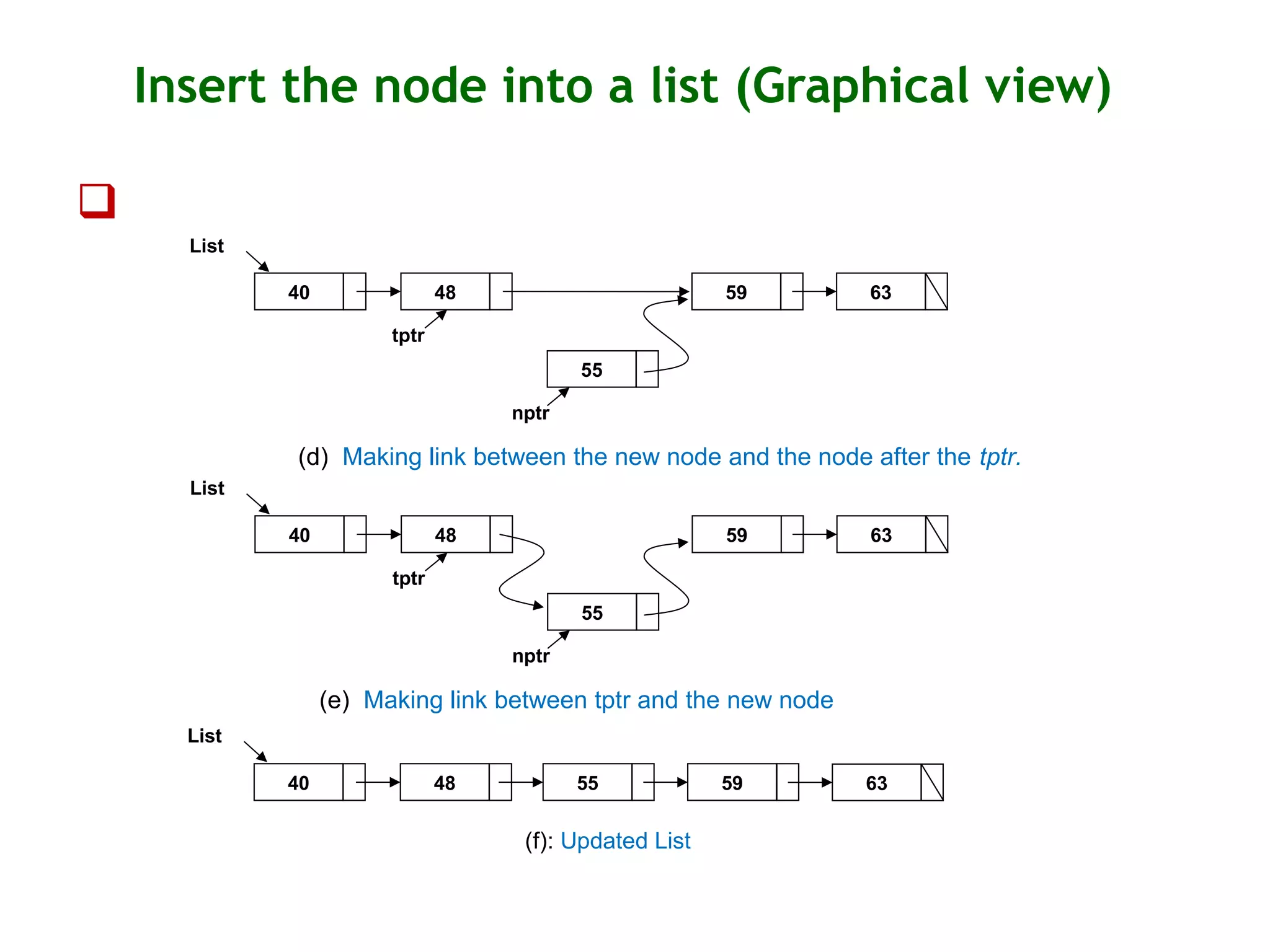
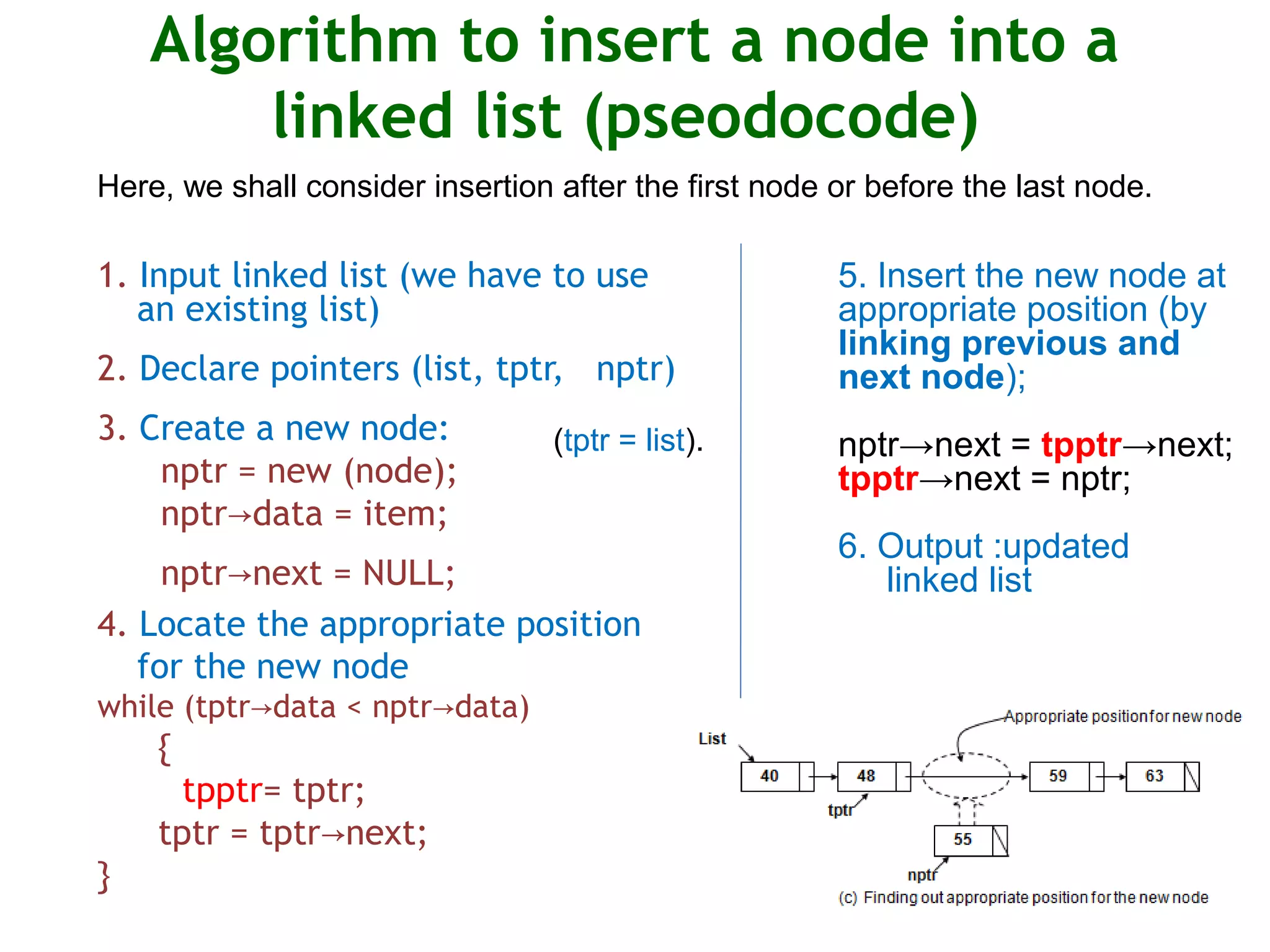
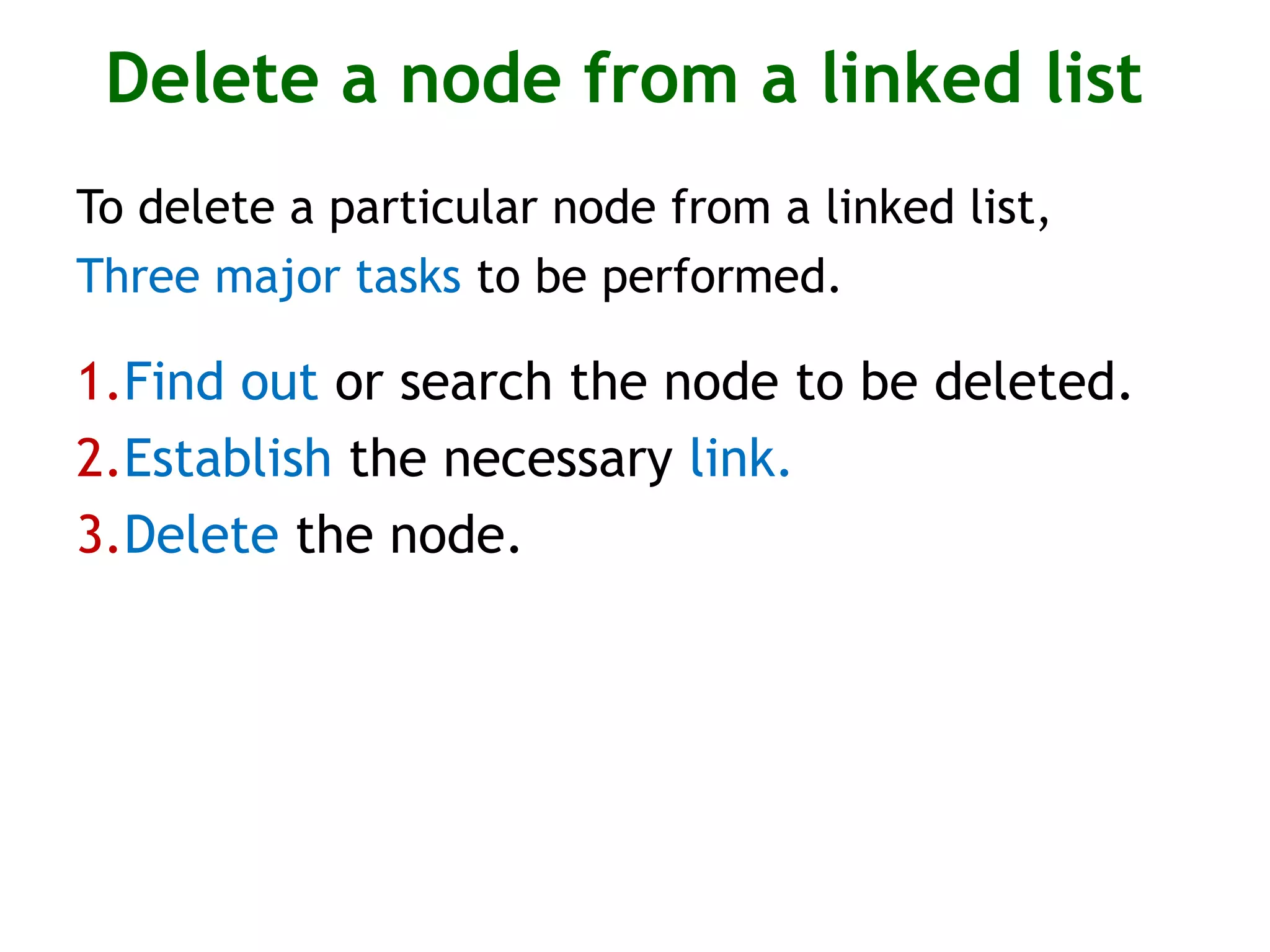
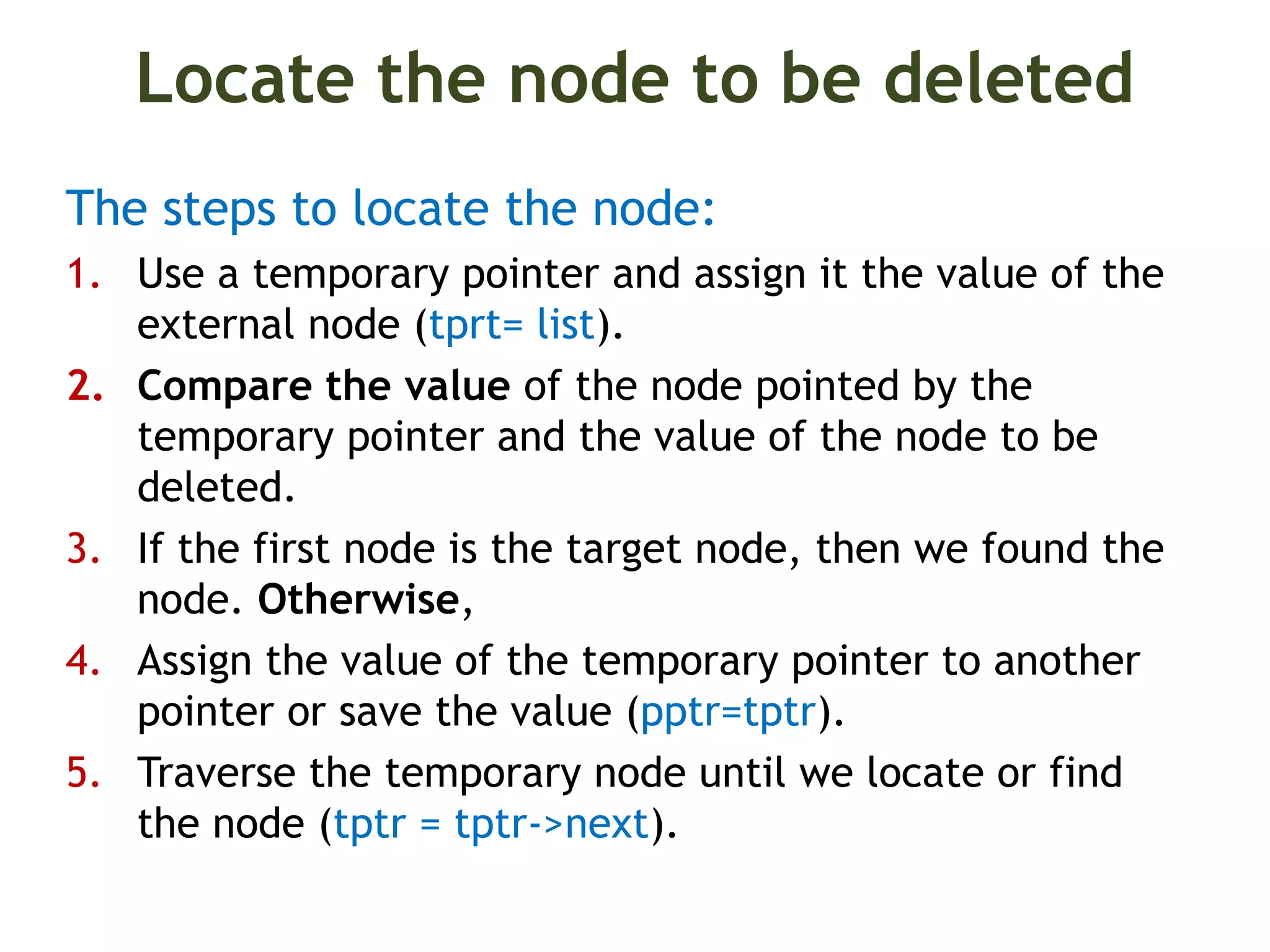

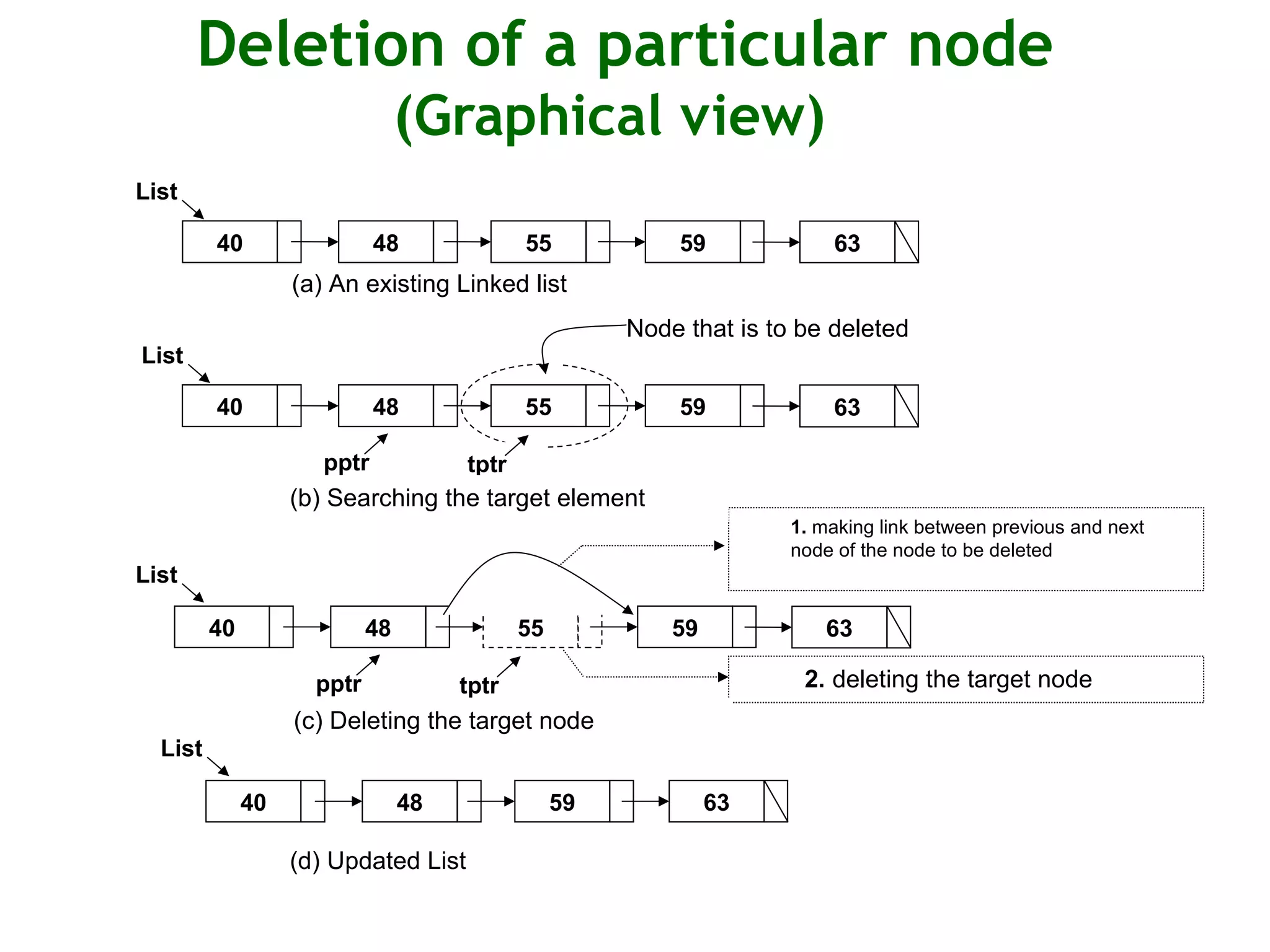
![Algorithm to delete a node from a linked list (pseudocode). Here we shall not consider the deletion process of the first node and the last node of the list. 1.Declare pointers (list, tptr, pptr) 2. Input linked list and the item (that is to be deleted) 3. Search the item to be deleted in the list: tptr = list; while (tptr data != item)→ {pptr = tptr; tptr = tptr next; }→ 4. Delete the node: [Make link between previous and next node of the node that is to be deleted and delete the target node] pptr next = tptr next;→ → delete (tptr); 5. Output: updated linked lists](https://image.slidesharecdn.com/linkedlist-chapter-5-180906055232/75/Data-Structures-with-C-Linked-List-33-2048.jpg)

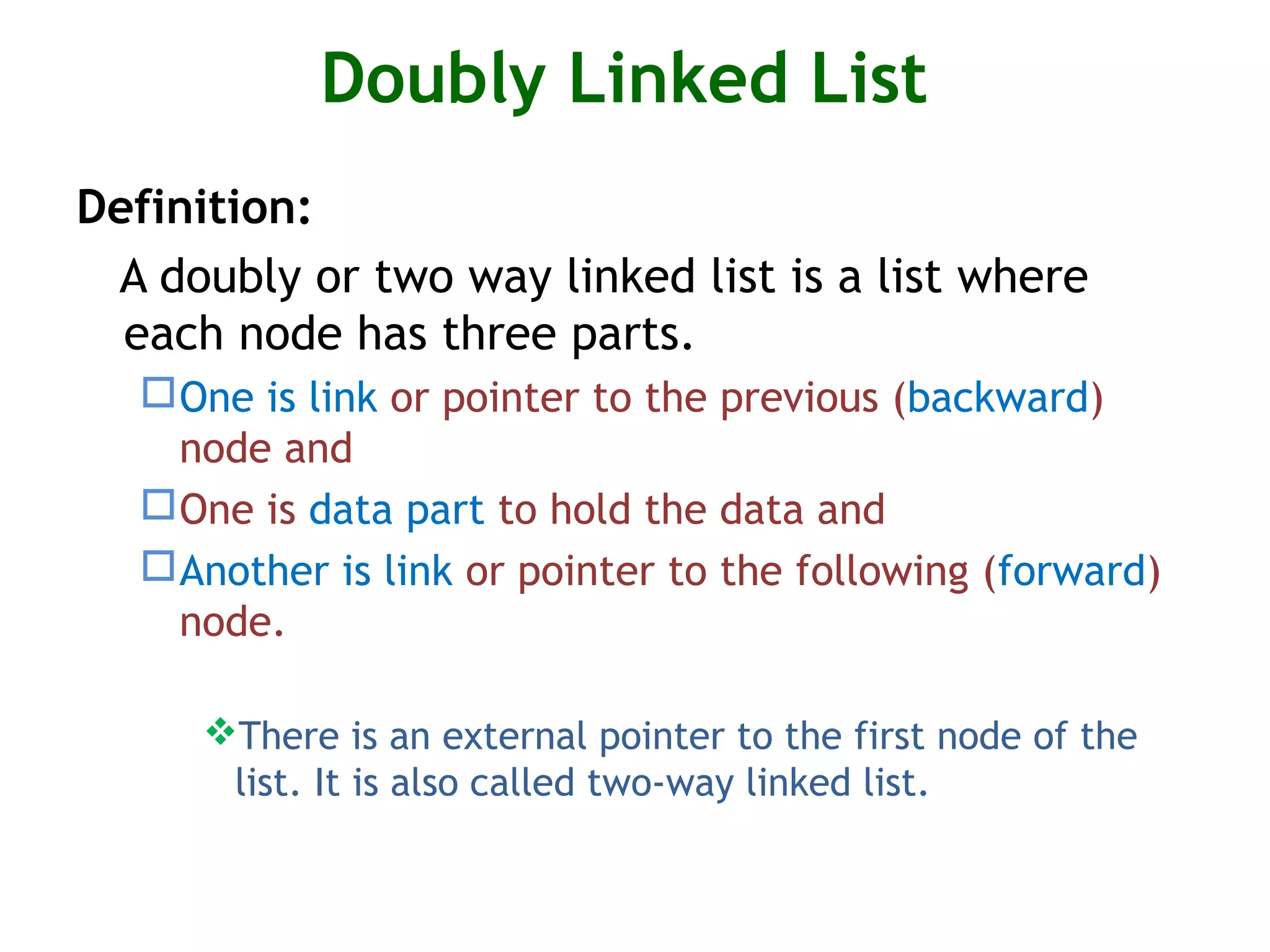
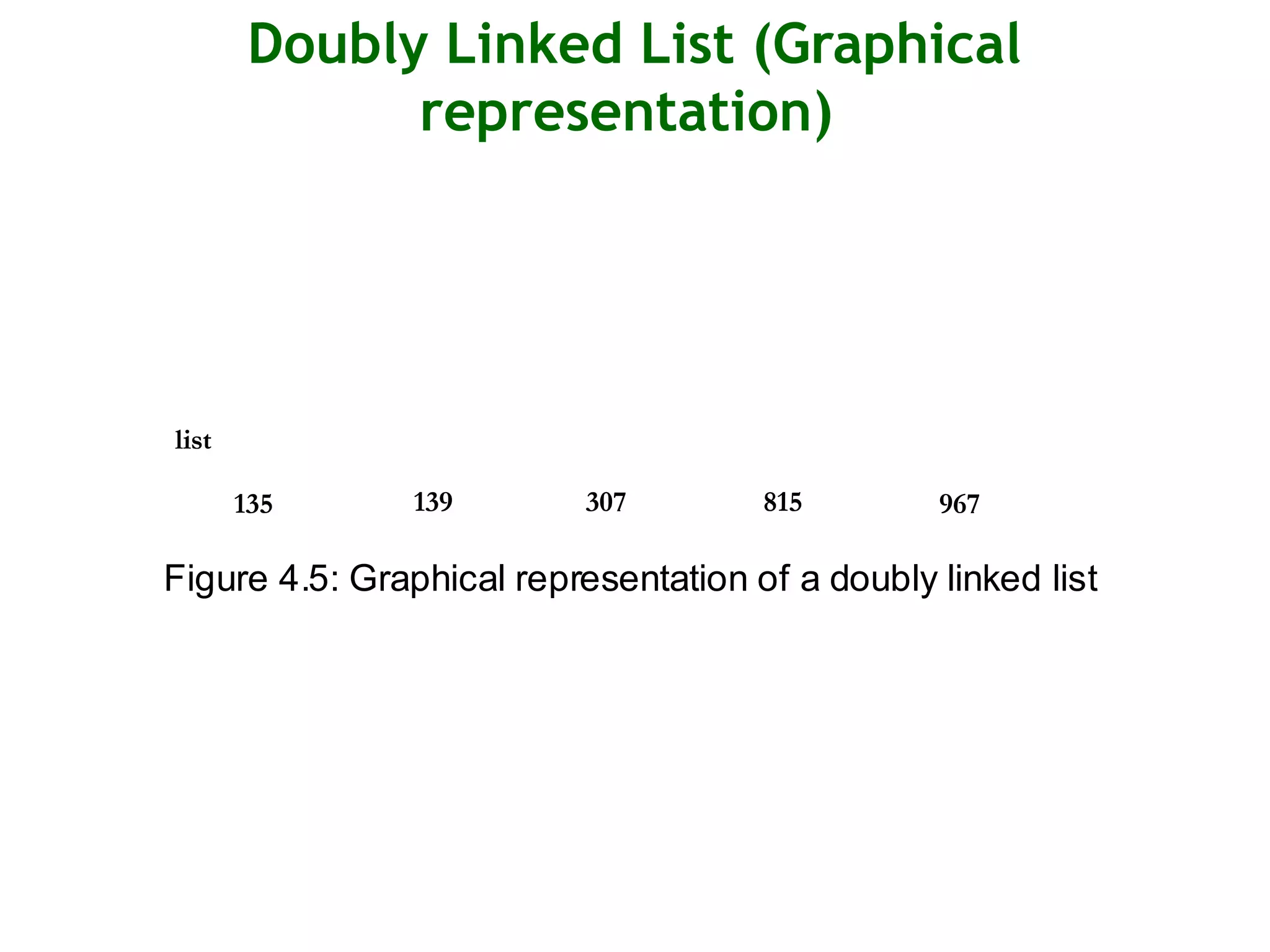



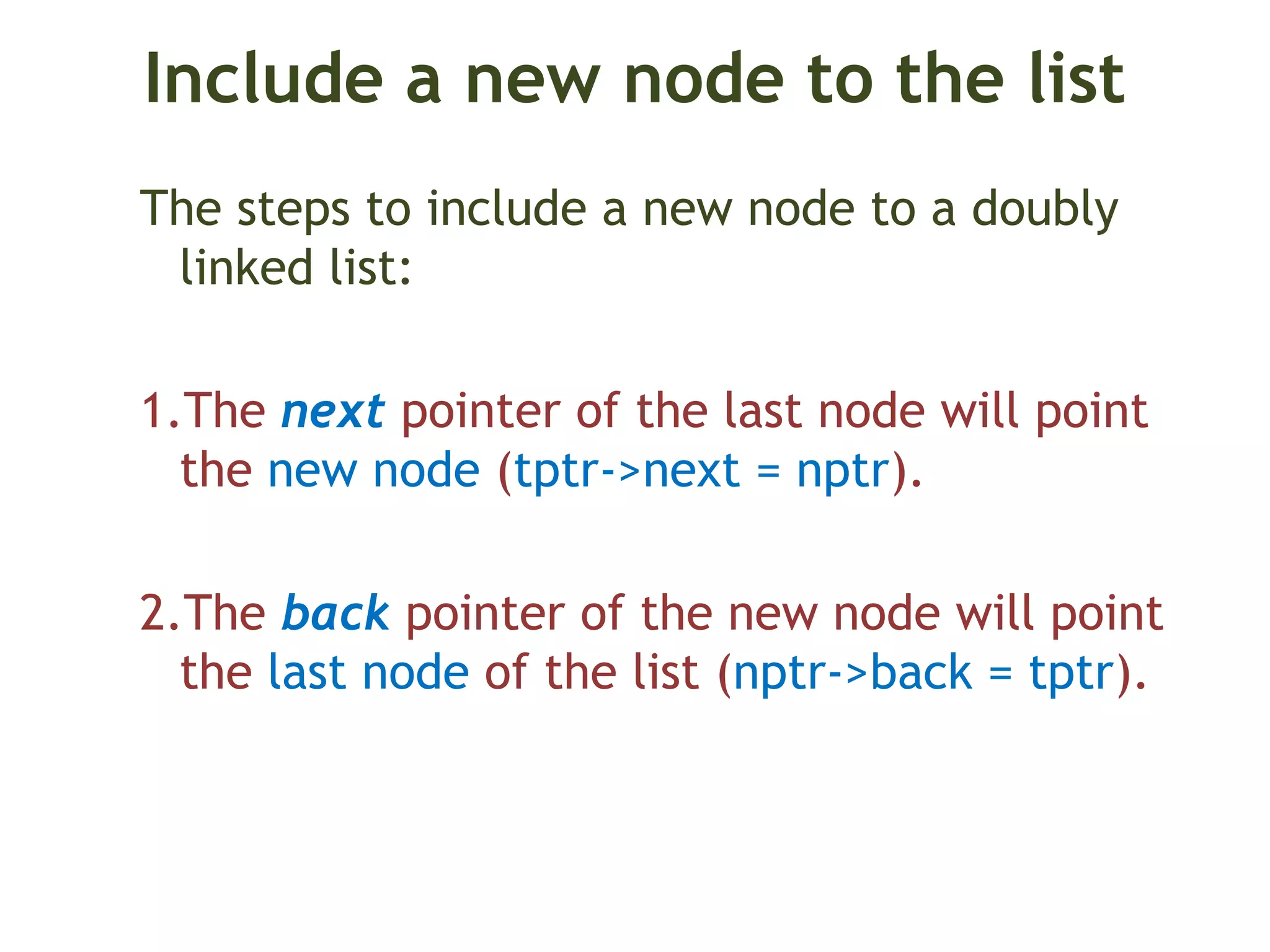
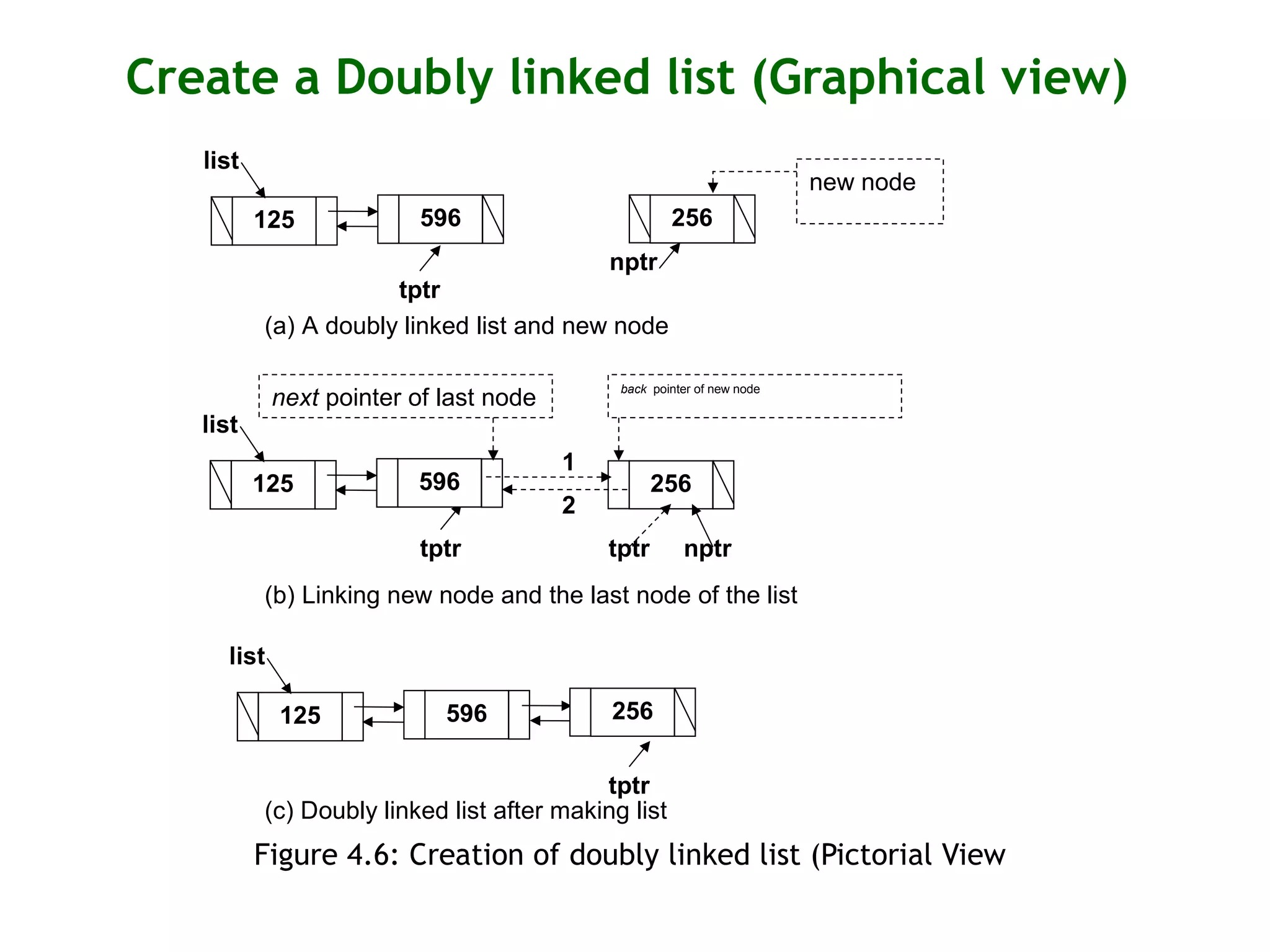

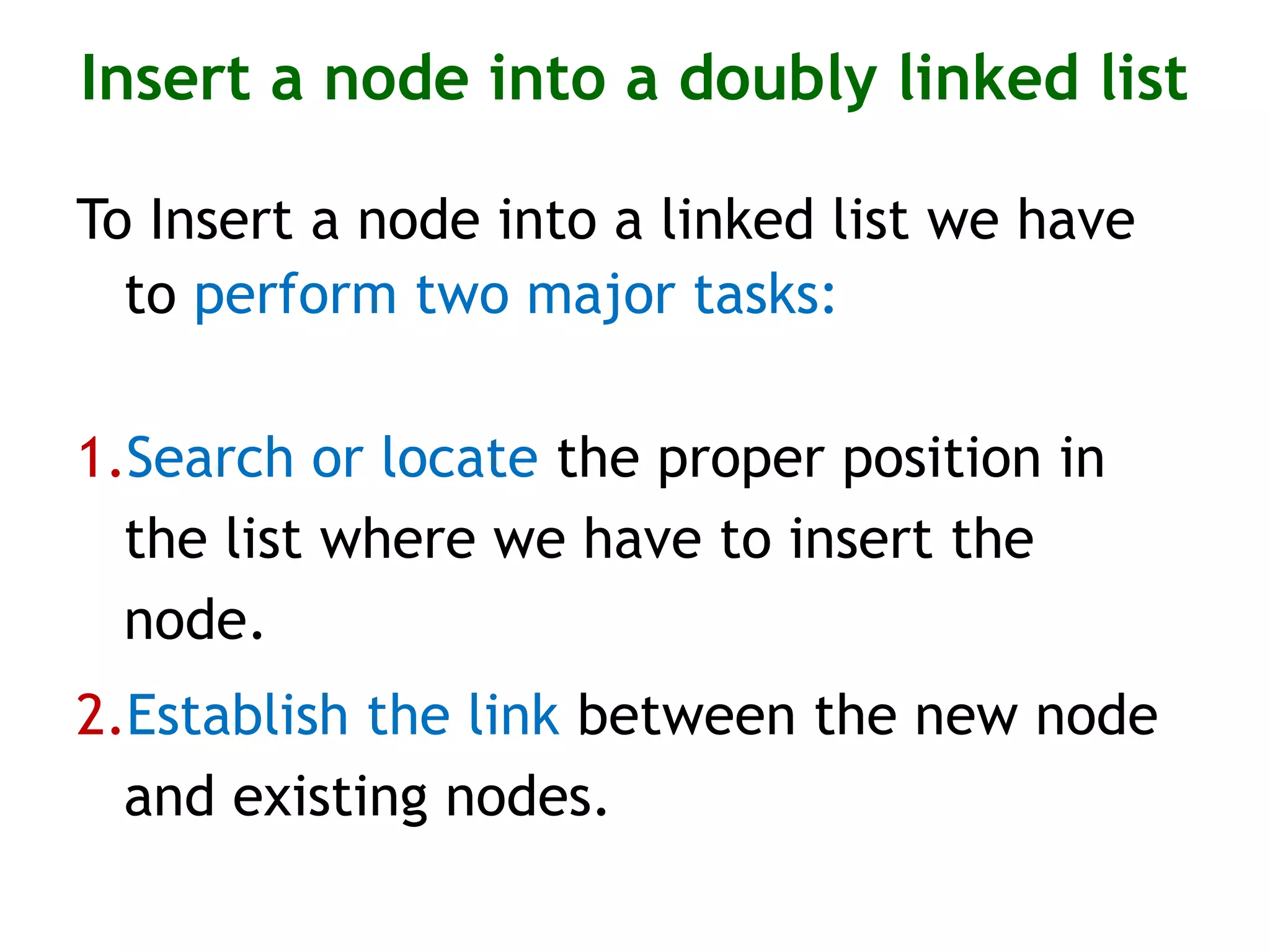
![Node insertion [Contin..] The steps to search the proper position for insertion: 1. Use temporary pointer (tptr) to find the position. 2. Start from the first node of the list (tptr = list). 3. Compare the data of the new node with the data of the next node to the temporary pointer. 4. If the data of the next node is greater, then we have found the position. Otherwise, 5. Traverse the temporary pointer (tprt = tptr->next). 6. Repeat the step 4 to step 6 until we find the position.](https://image.slidesharecdn.com/linkedlist-chapter-5-180906055232/75/Data-Structures-with-C-Linked-List-44-2048.jpg)
![Node Insertion (Cont..] Making link in case of insertion of new node in between two nodes: The following are the steps to establish link: 1. Make link from the new node to the next node (of the new node’s position). 2. Make link from the next node to the new node. 3. Make link from the new node to the previous node (of the new node’s position). 4. Make link from the previous node to the new nodeh 180 256 310 13 4 2](https://image.slidesharecdn.com/linkedlist-chapter-5-180906055232/75/Data-Structures-with-C-Linked-List-45-2048.jpg)
![Node Insertion (Cont..] Making link in case of insertion of new node in between two nodes: tptr nptr The following are the codes to establish link: 1. nptr ->next = tptr ->next; 2. tptr ->next ->back = nptr; 3. nptr ->back = tptr; 4. tptr ->next = nptr; 180 256 310 13 4 2](https://image.slidesharecdn.com/linkedlist-chapter-5-180906055232/75/Data-Structures-with-C-Linked-List-46-2048.jpg)
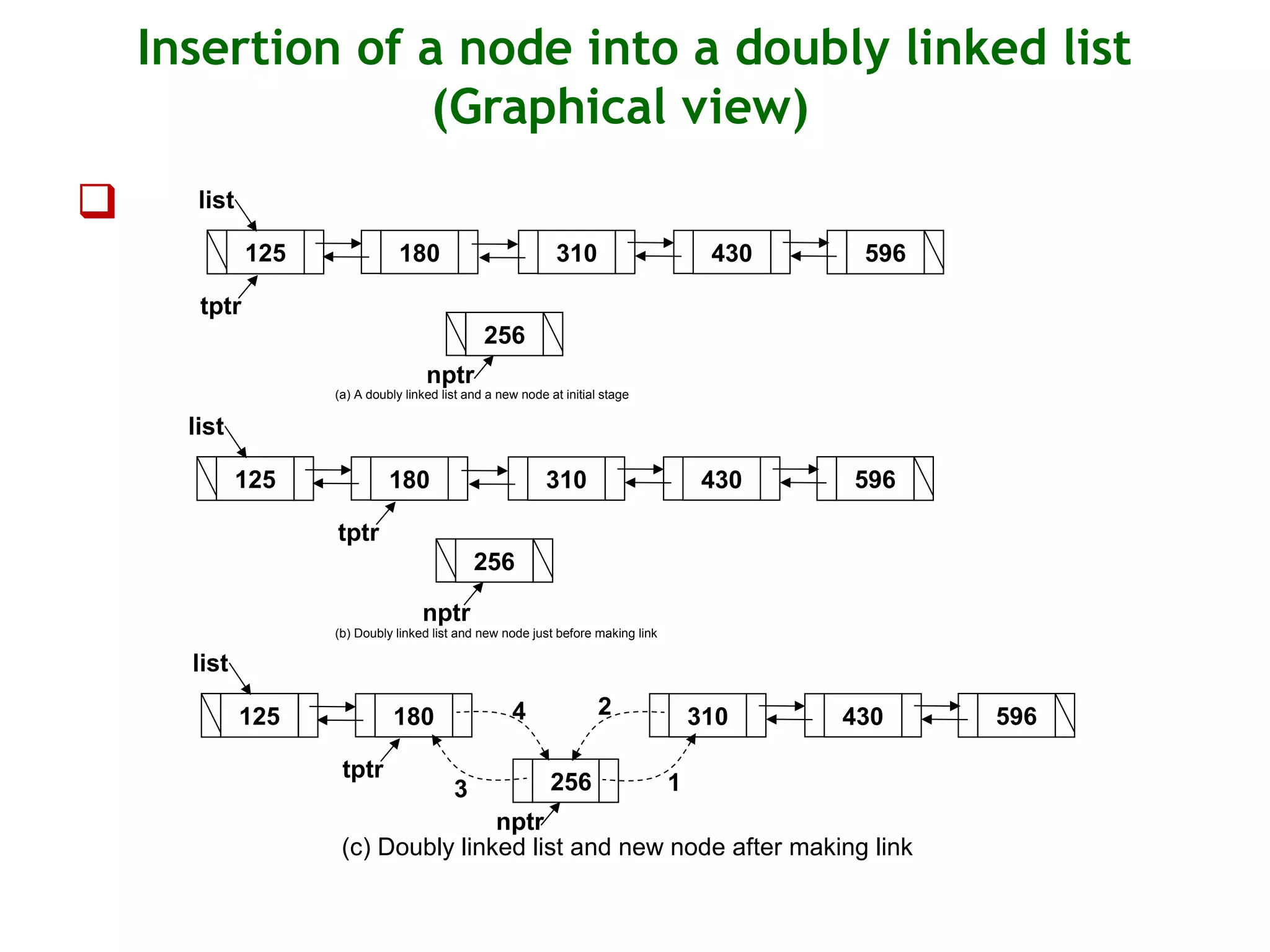
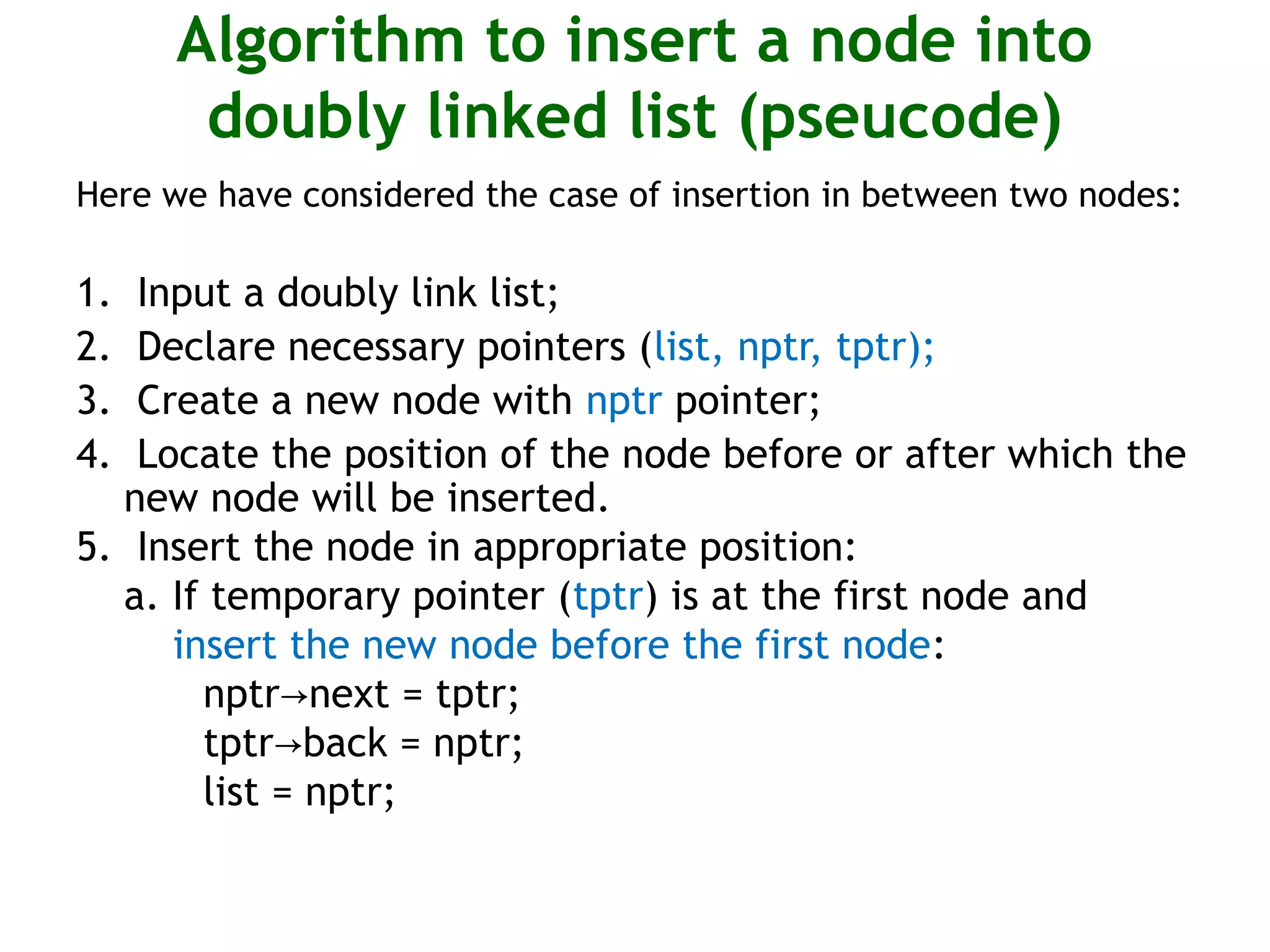
![Algorithm to insert a node into doubly linked list [contd.] b. If temporary pointer (tptr) is not at the first or at the last node and insert in between two nodes: nptr next = tptr next;→ → tptr next back = nptr;→ → nptr back = tptr;→ tptr next = nptr;→ c. If temporary pointer is at the last node and insert after last node: tptr next = nptr;→ nptr back = tptr;→ 6. Output: Updated linked list.](https://image.slidesharecdn.com/linkedlist-chapter-5-180906055232/75/Data-Structures-with-C-Linked-List-49-2048.jpg)
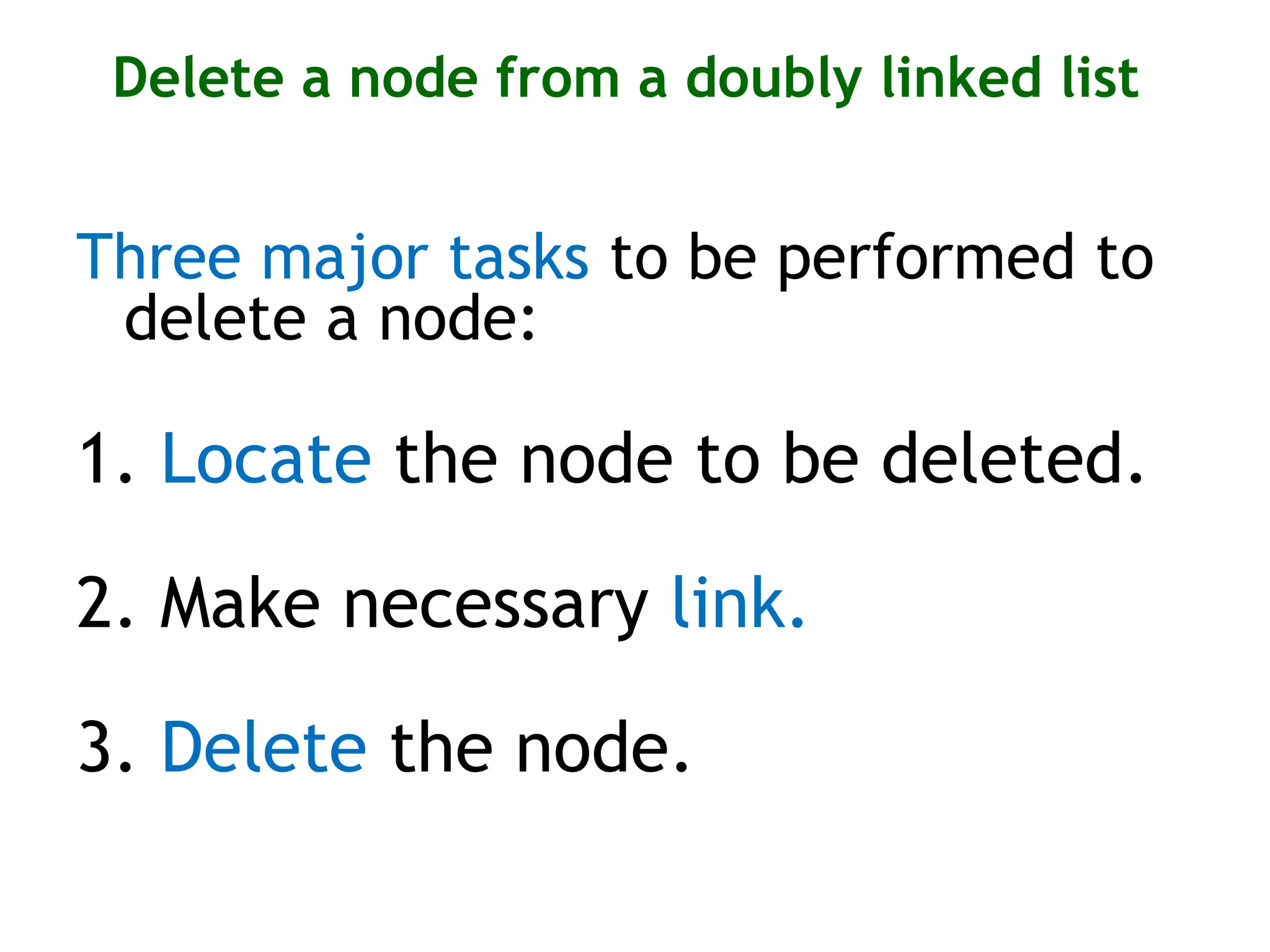
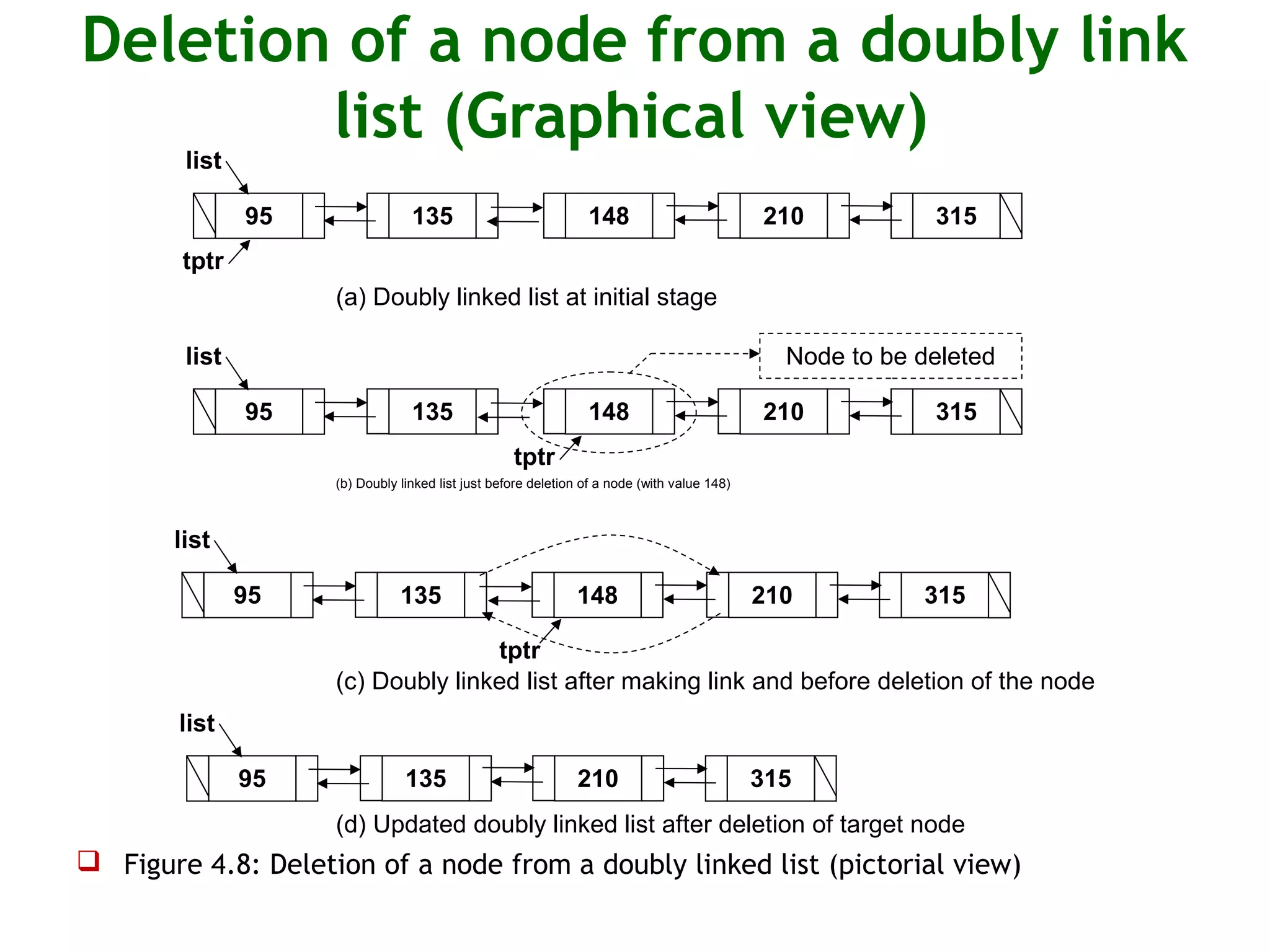
![Node Deletion (Cont..] tptr The following are the steps to establish link: 1. Make link from the previous node to the next node (of the node to be deleted). 2. Make link from the next node to the previous node (of the node to be deleted). 135 148 210 2 1](https://image.slidesharecdn.com/linkedlist-chapter-5-180906055232/75/Data-Structures-with-C-Linked-List-52-2048.jpg)
![Node Deletion (Cont..] tptr Establishing link using code: 1. tptr->back->next = tptr->next; 2. tptr-next->back = tptr->back; 135 148 210 2 1](https://image.slidesharecdn.com/linkedlist-chapter-5-180906055232/75/Data-Structures-with-C-Linked-List-53-2048.jpg)
![Algorithm to delete a node from a doubly linked list (pseudocode) 1. Input a doubly link list and item (value of the node to be deleted); 2. Declare necessary pointers (list, tptr); 3. Locate the node to be deleted: tptr = list; while (tptr next != NULL)→ { if (tptr data = = item) break;→ tptr = tptr next;→ } 4. Make link: a. If the node to be deleted is the first node of the list: list = tptr next;→ list back = NULL;→ [if there is only one node in the list then list = NULL]](https://image.slidesharecdn.com/linkedlist-chapter-5-180906055232/75/Data-Structures-with-C-Linked-List-54-2048.jpg)
![Algorithm to delete a node [Cont..] b. If the node to be deleted is not the last node: tptr back next = tptr next;→ → → tptr next back = tptr back;→ → → c. If the node to be deleted is the last node: tptr back next = NULL;→ → 5. Delete the target node: delete (tptr); 6. Output: Updated doubly linked list.](https://image.slidesharecdn.com/linkedlist-chapter-5-180906055232/75/Data-Structures-with-C-Linked-List-55-2048.jpg)

![Circular Linked List [contd.] Figure 4.9: Pictorial view of a circular linked list (a circular diagram) List](https://image.slidesharecdn.com/linkedlist-chapter-5-180906055232/75/Data-Structures-with-C-Linked-List-57-2048.jpg)
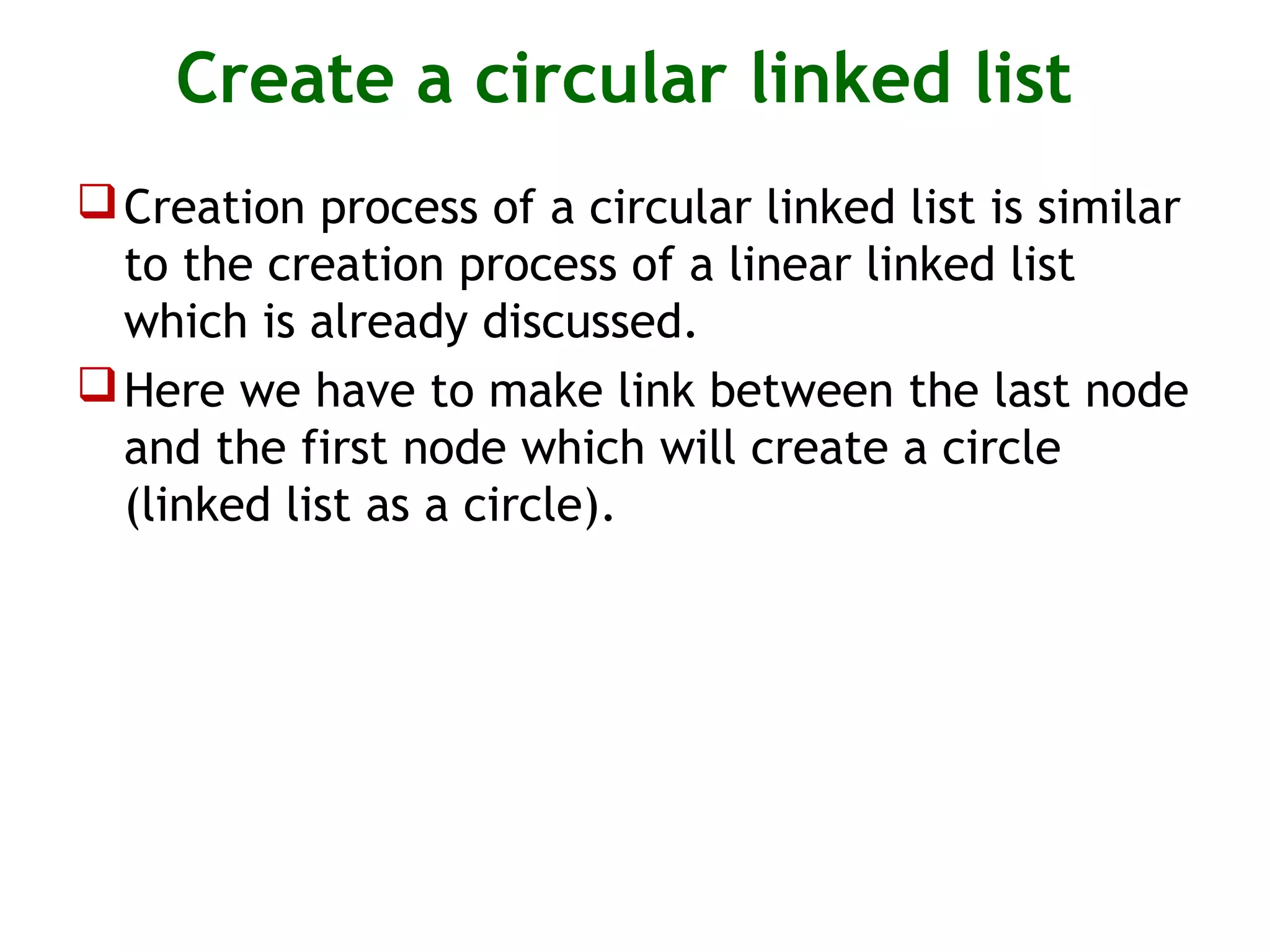

![Create a circular linked list [contd.] Figure 4.12: Creation of a circular linked list with more than one node 40 List 63 tptr 1 2 (i) A circular list with one node (iii) Making link between last node & new node, new node & first node. (iv) Updated circular linked list after making link. 40 List tptr 63 3. Forward tptr tptrnptrnptr 2 40 List 63 tptr (ii) A new node (delete)](https://image.slidesharecdn.com/linkedlist-chapter-5-180906055232/75/Data-Structures-with-C-Linked-List-60-2048.jpg)
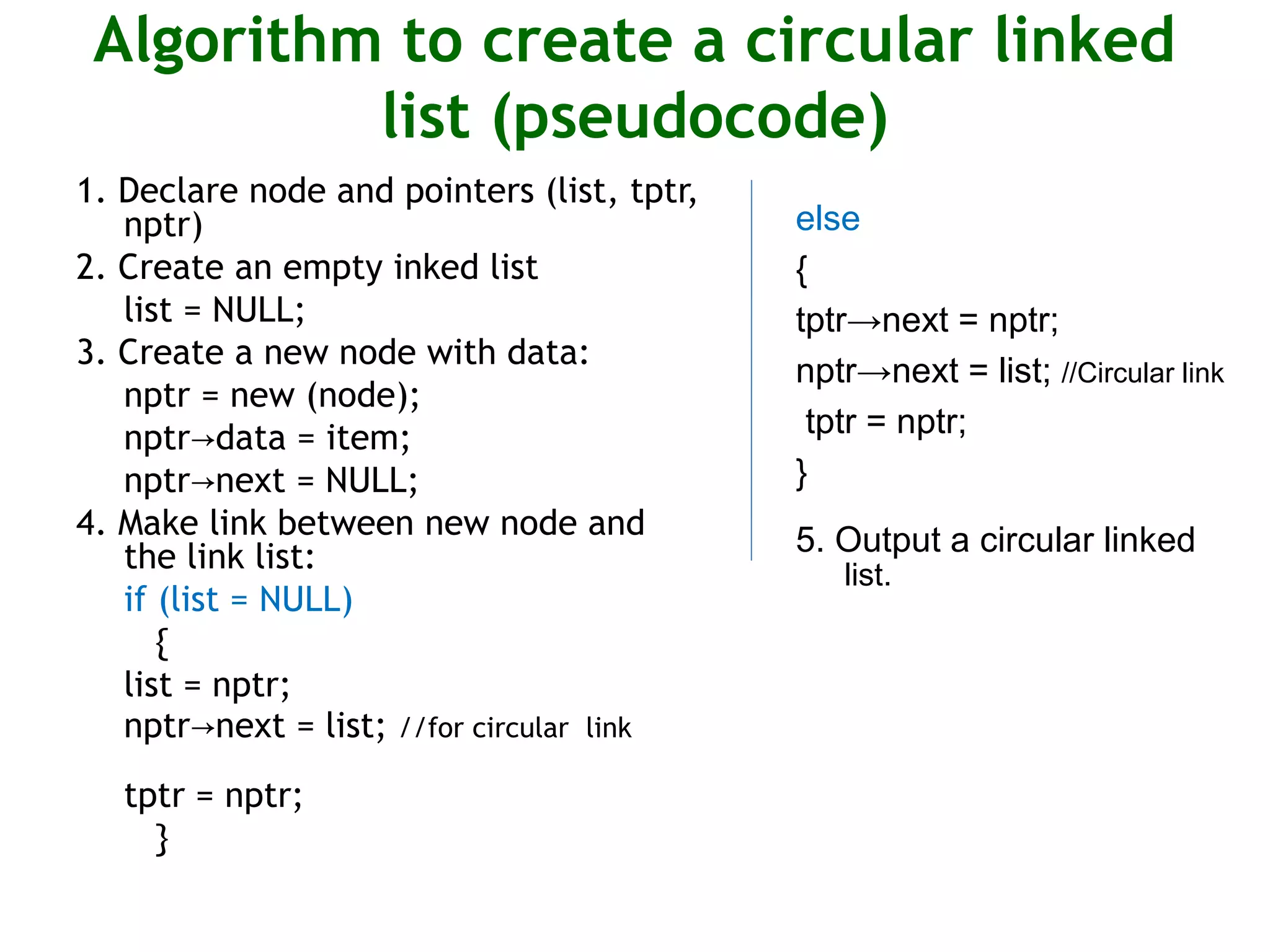
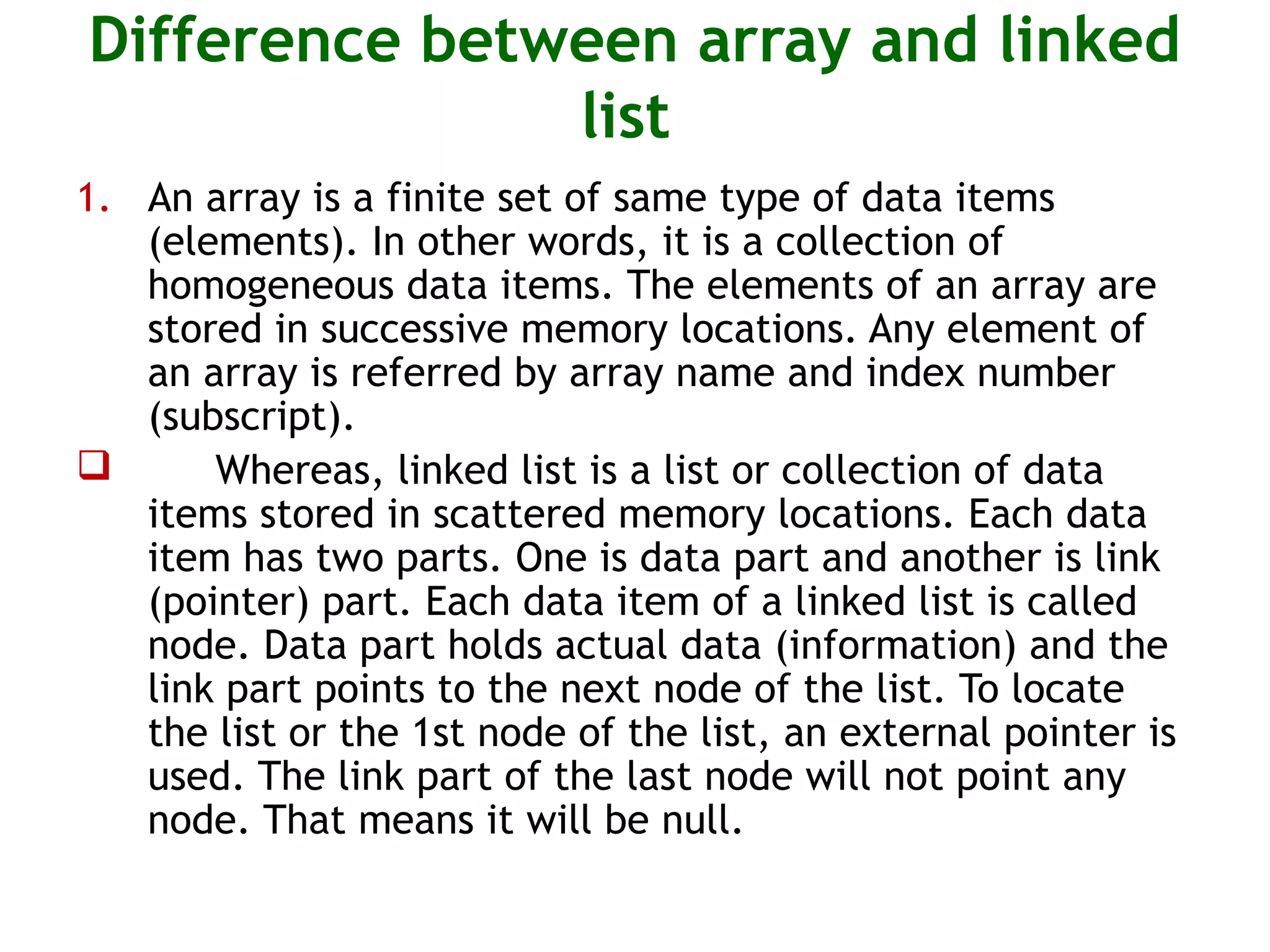
![Difference between array and linked list [contd.] 2. Array implementation depends on size and it results in wastage of memory space. On the other hand, linked list does not depend on size. 3. Types of array are one dimensional, two dimensional etc. and types of linked list are linear, doubly, circular etc. 4. An element of an array can be accessed directly and access time is fixed as well as efficient. On the other hand, a node of a linked list can not be accessed directly and access time is linear and not so efficient. 5. Array is a static data structure and a linked list is a dynamic data structure.](https://image.slidesharecdn.com/linkedlist-chapter-5-180906055232/75/Data-Structures-with-C-Linked-List-63-2048.jpg)
